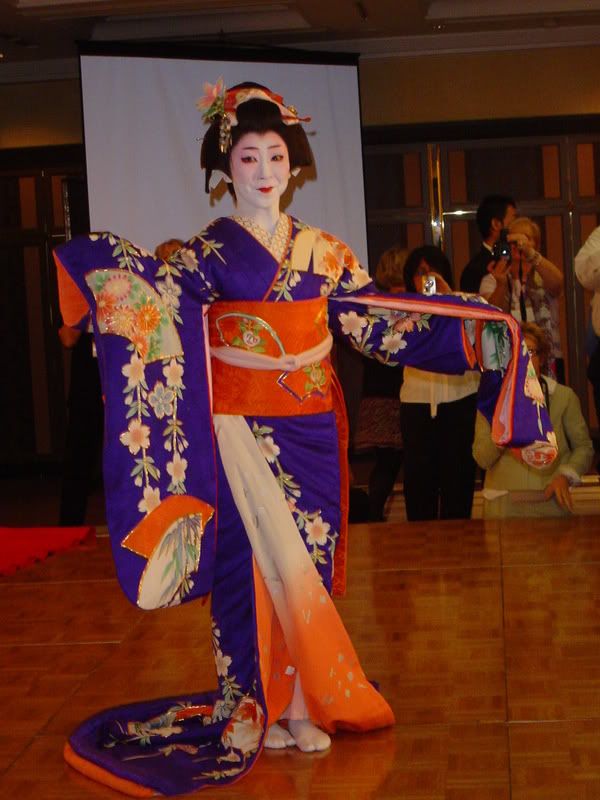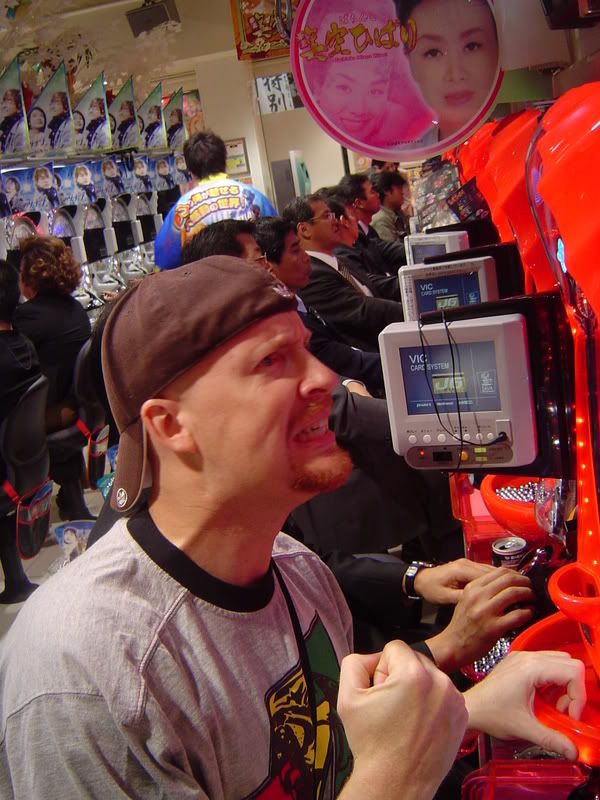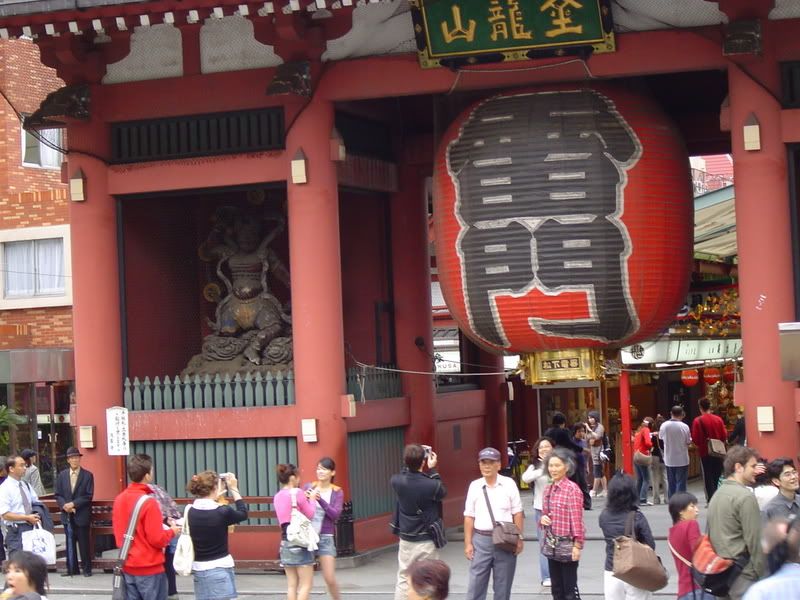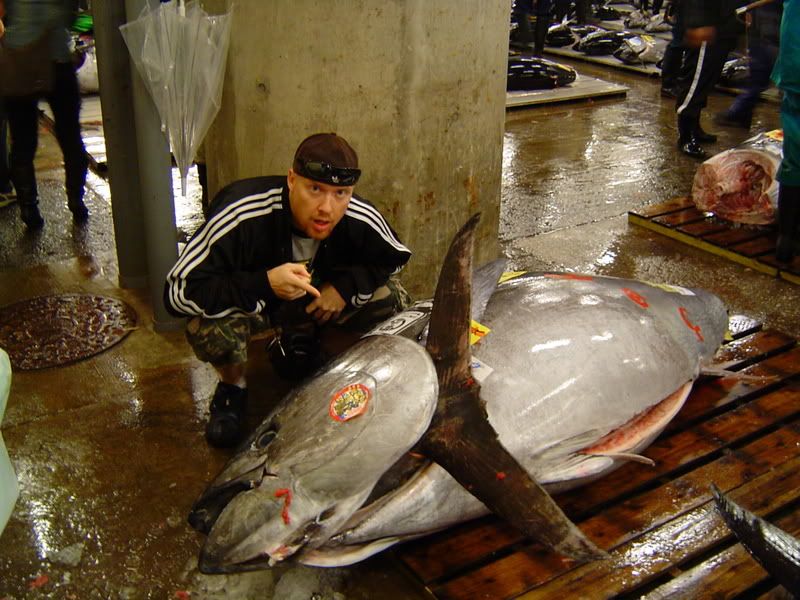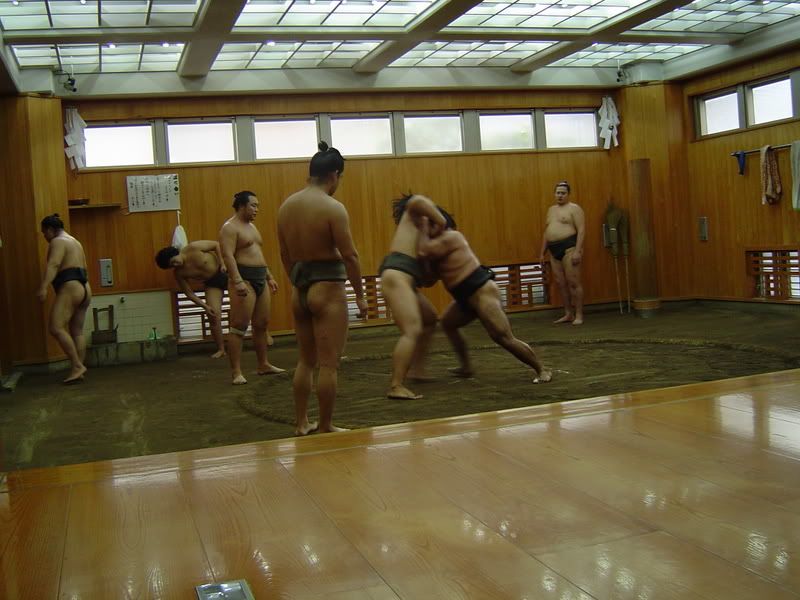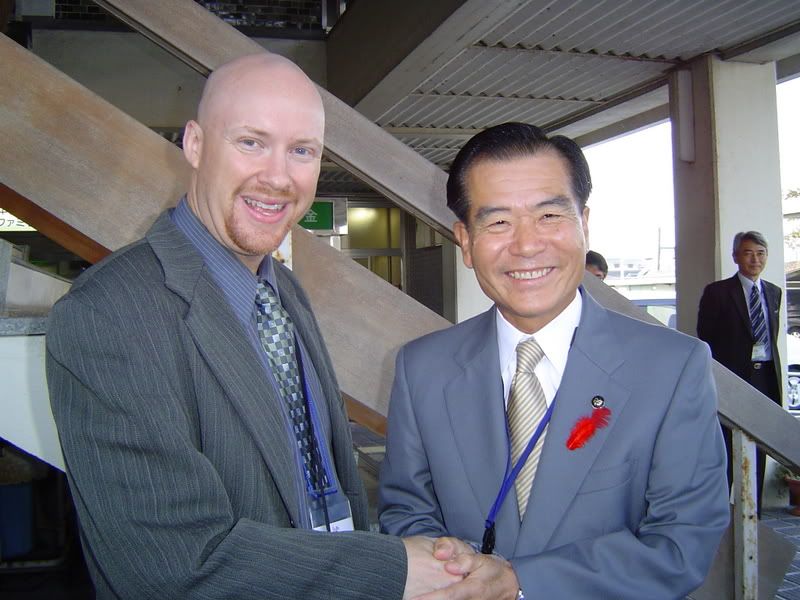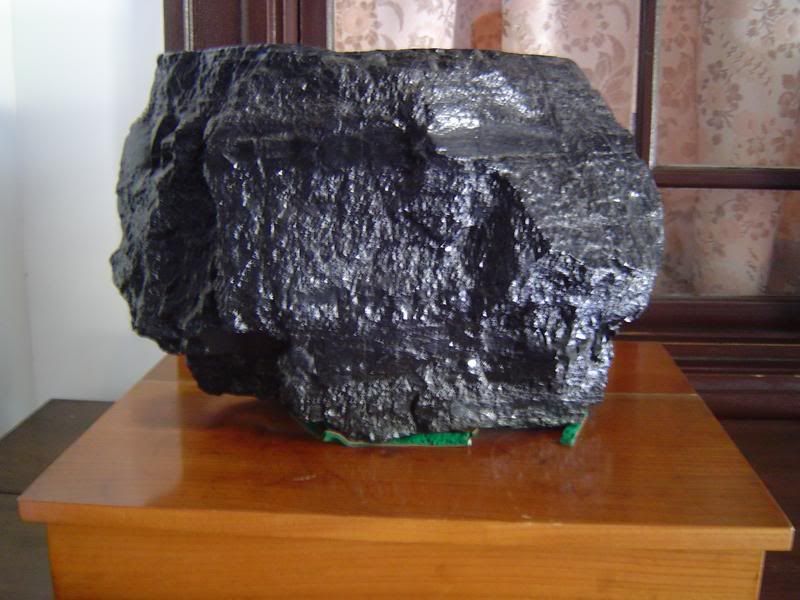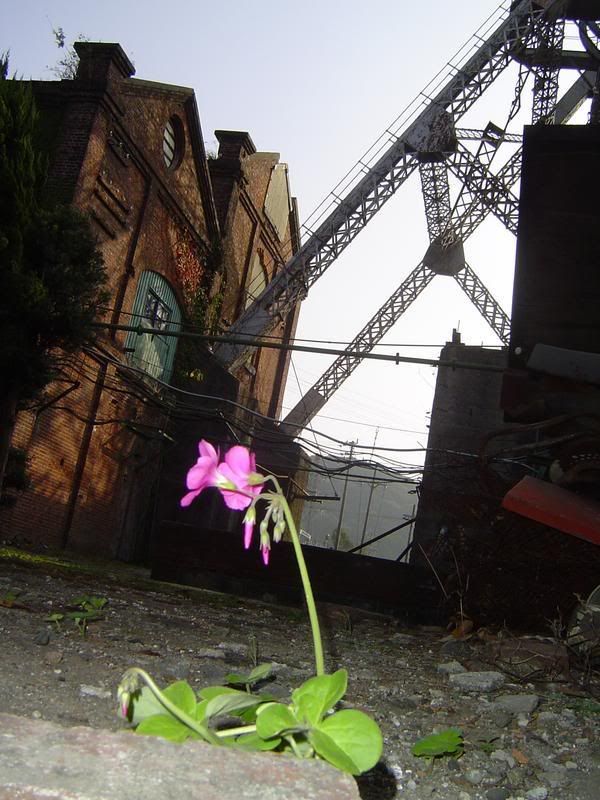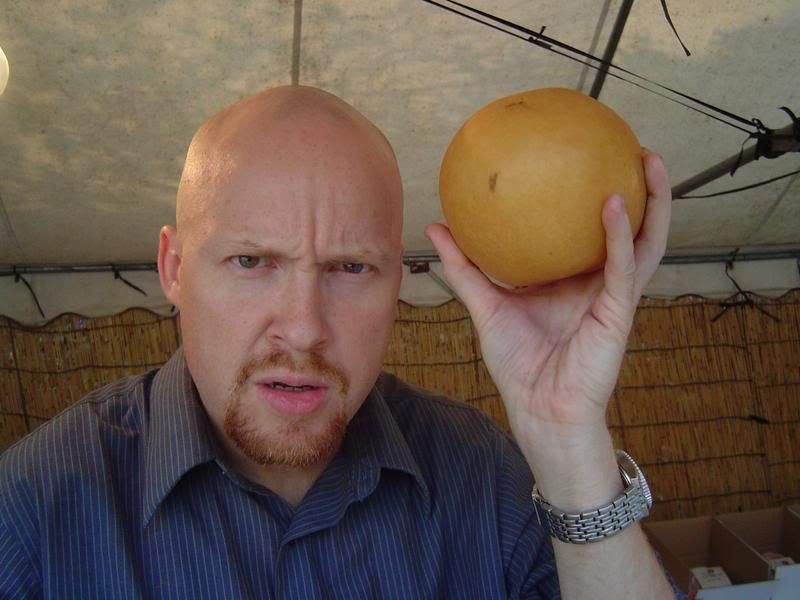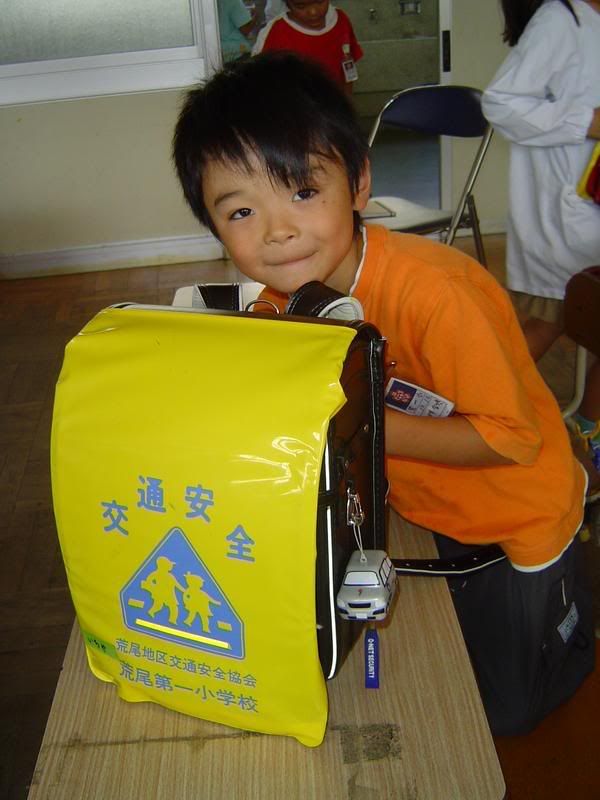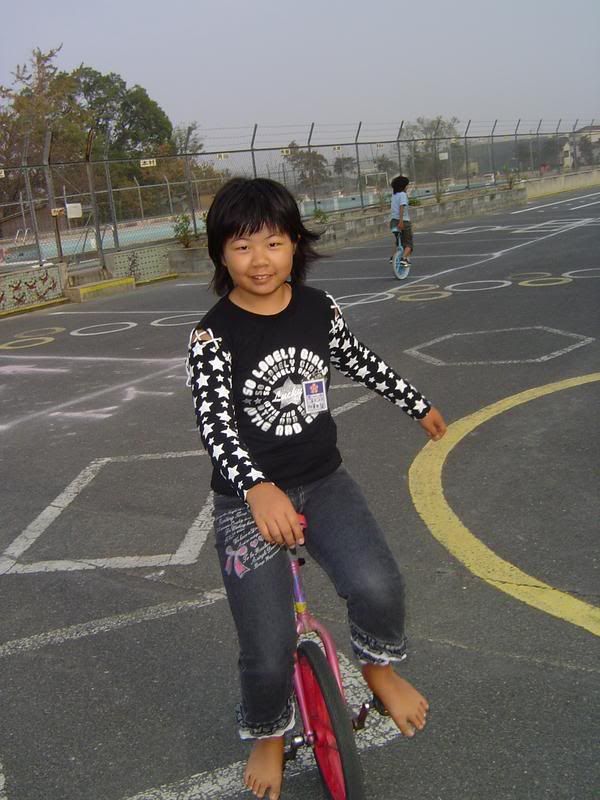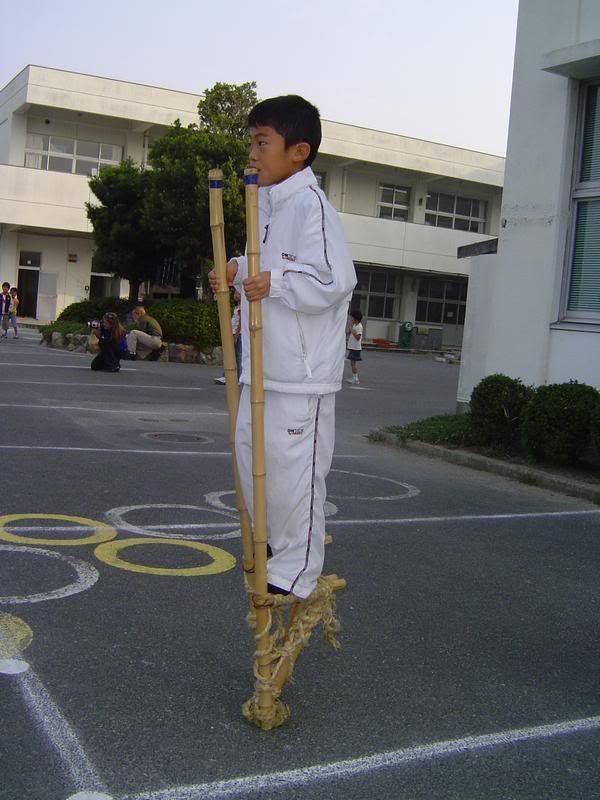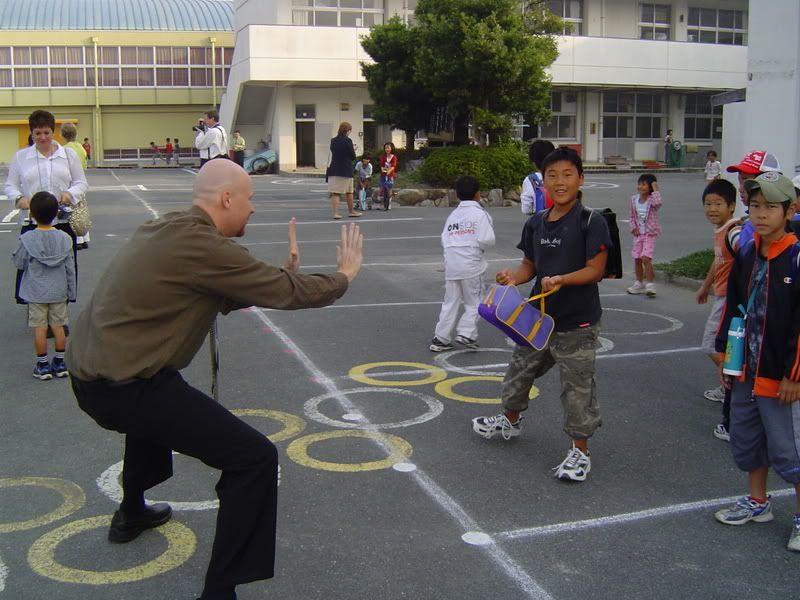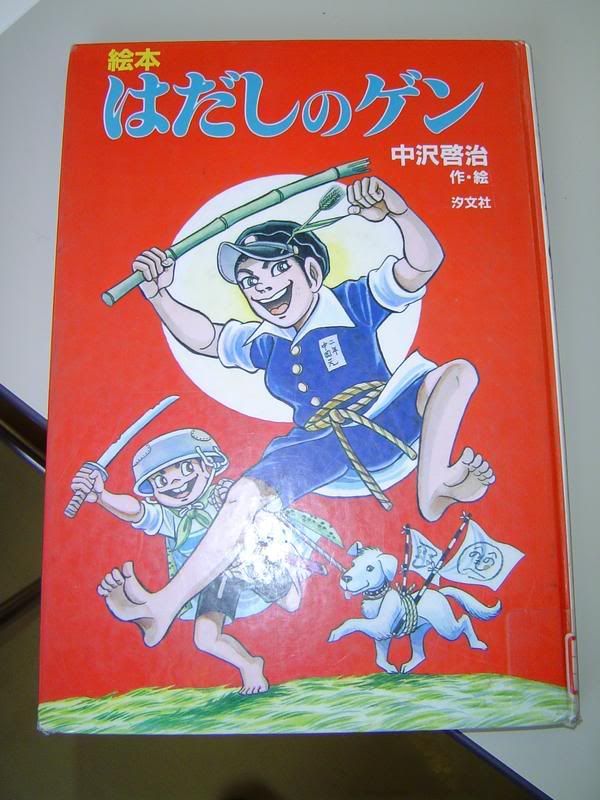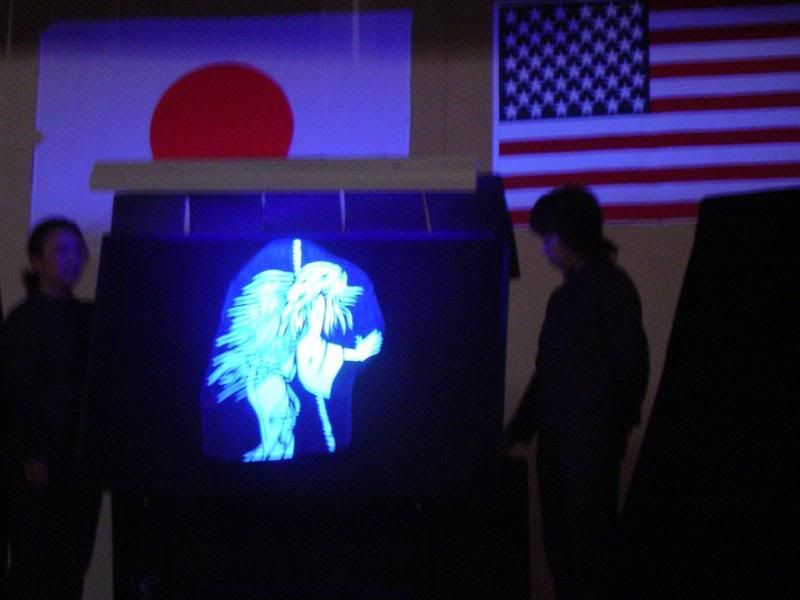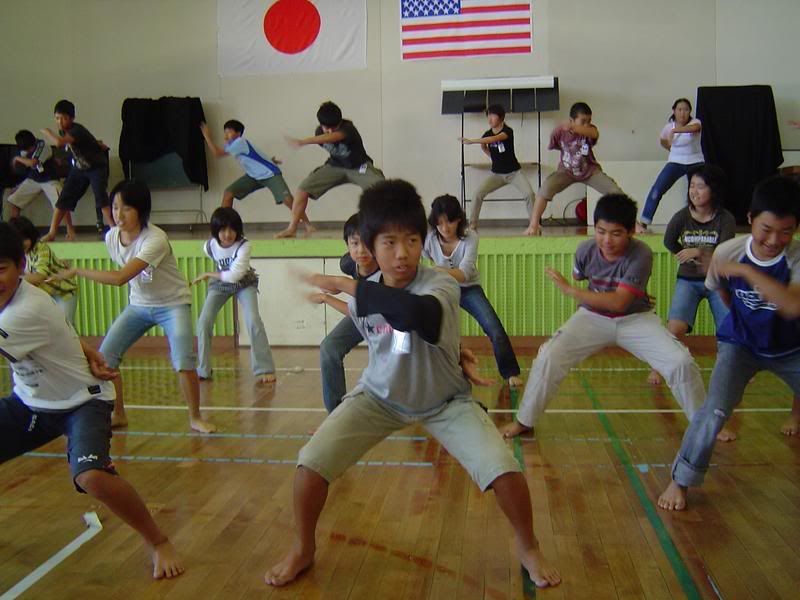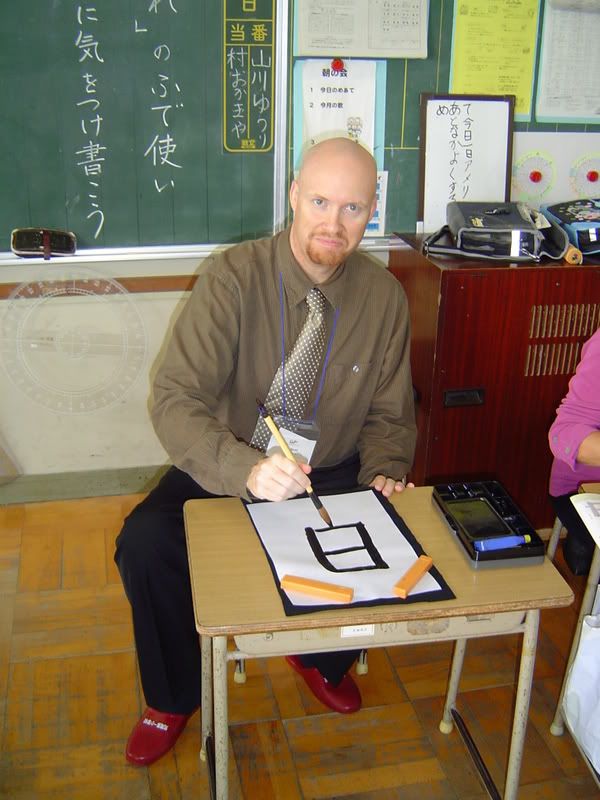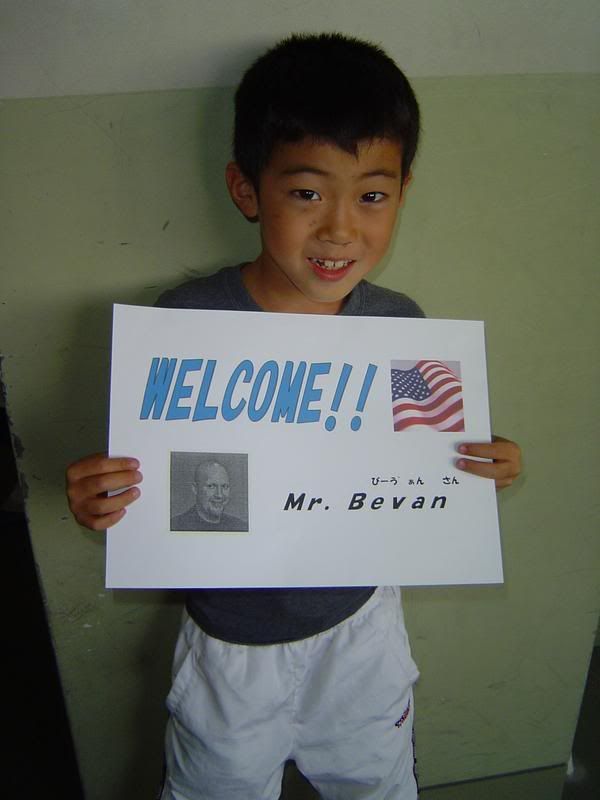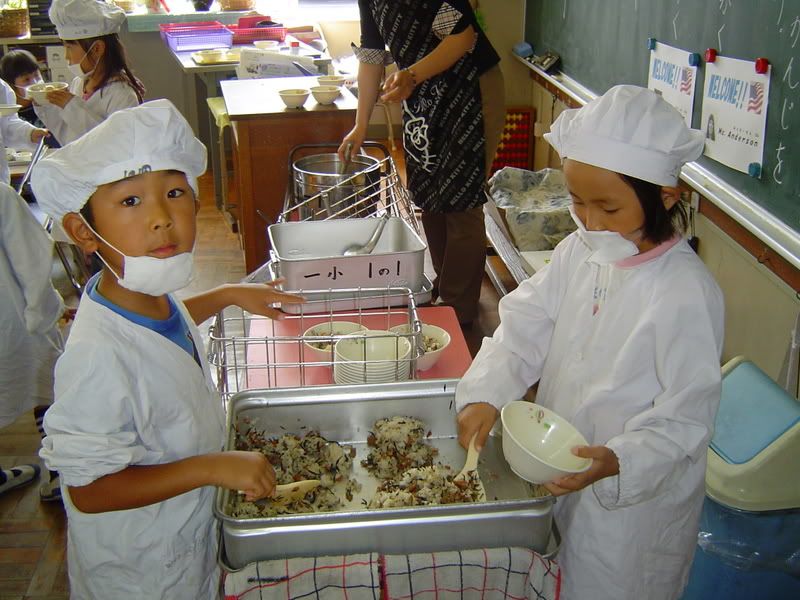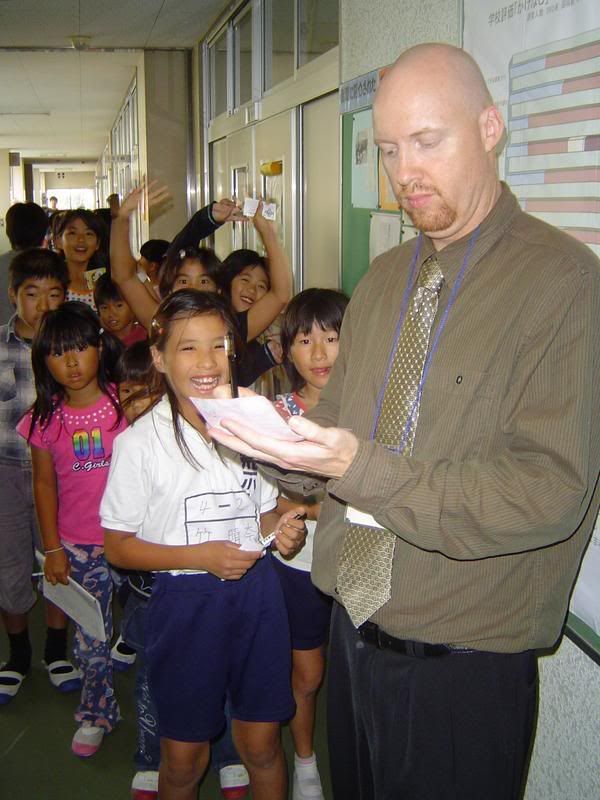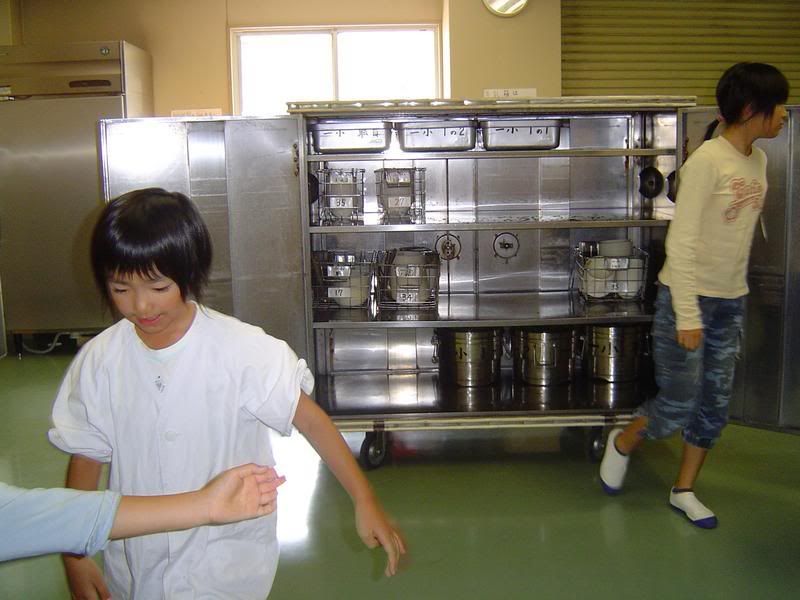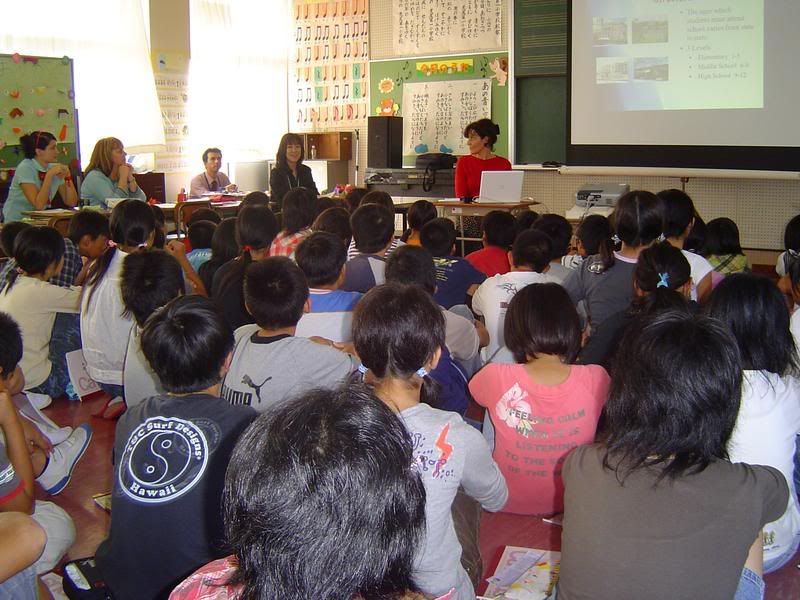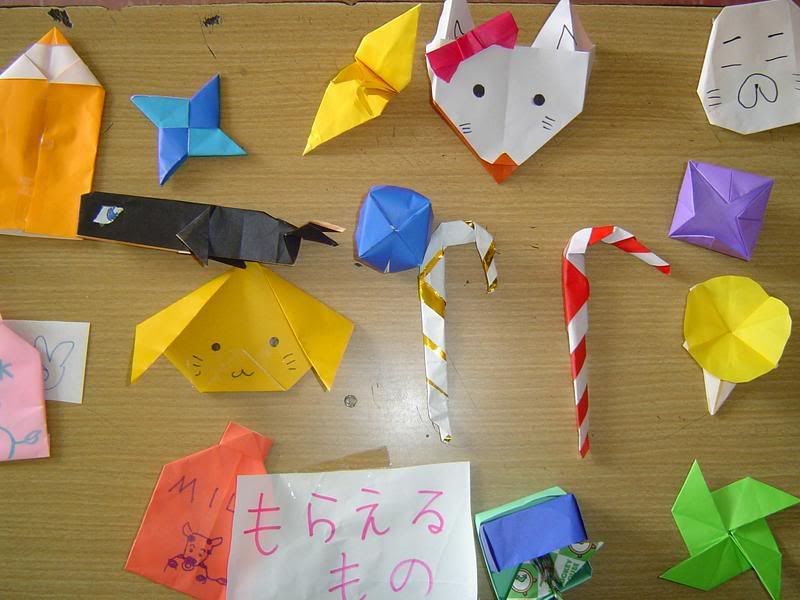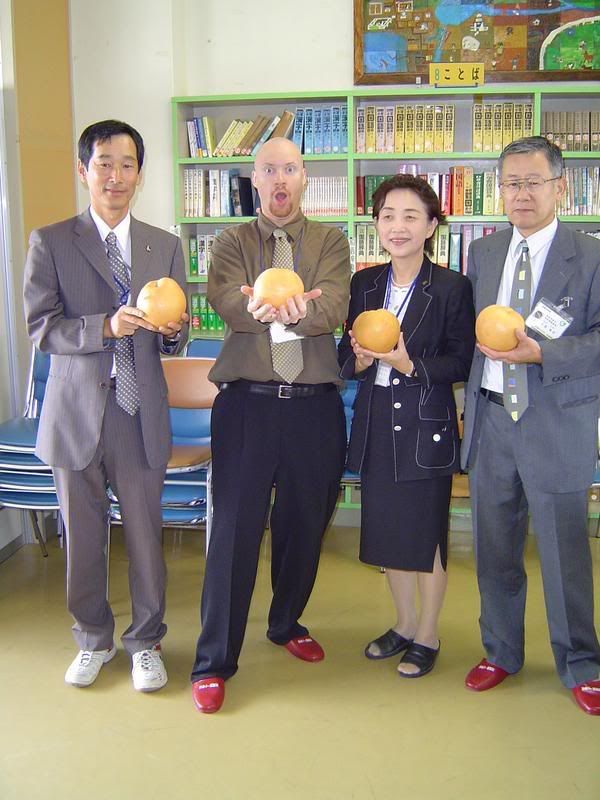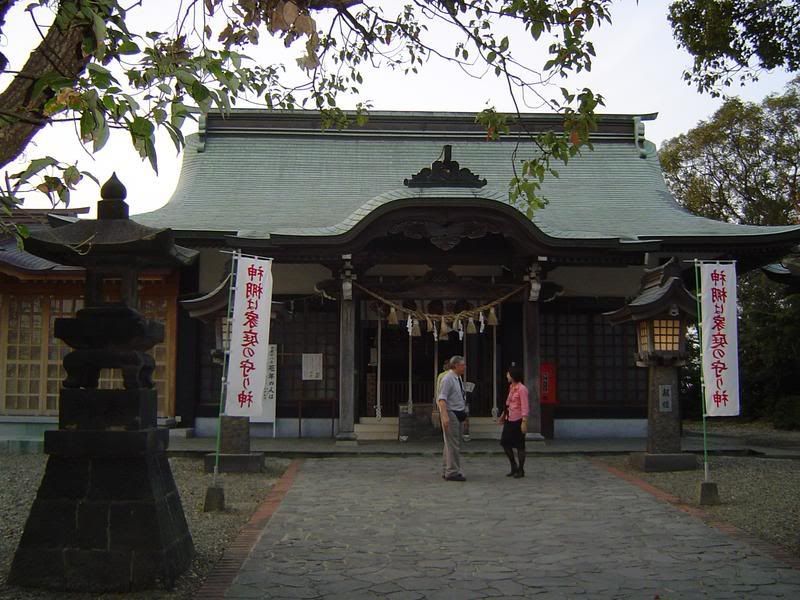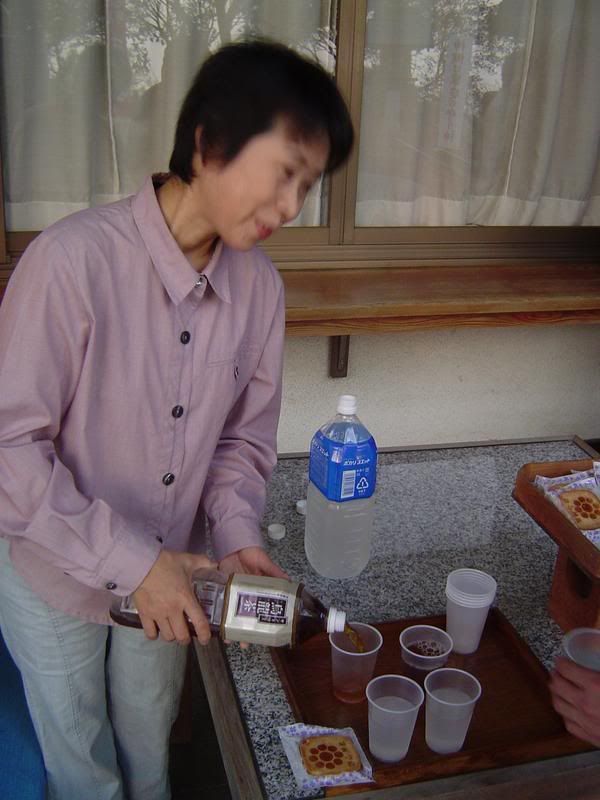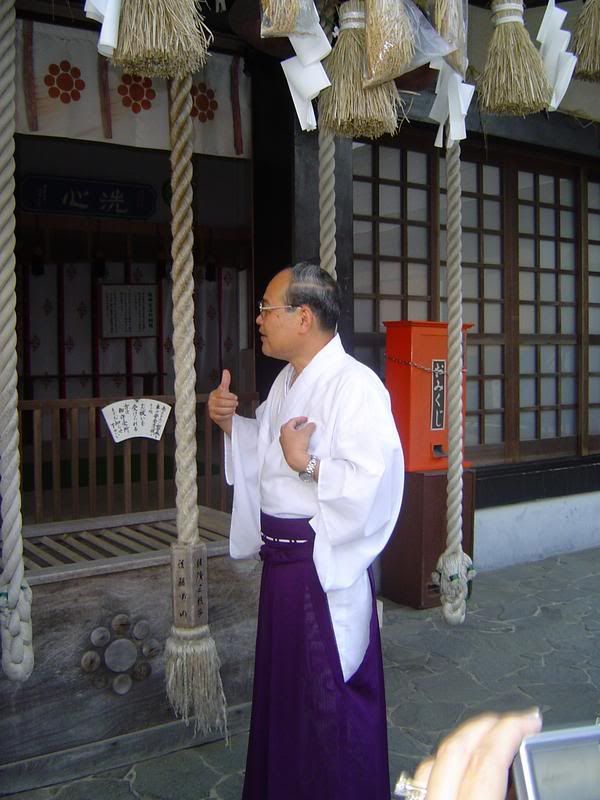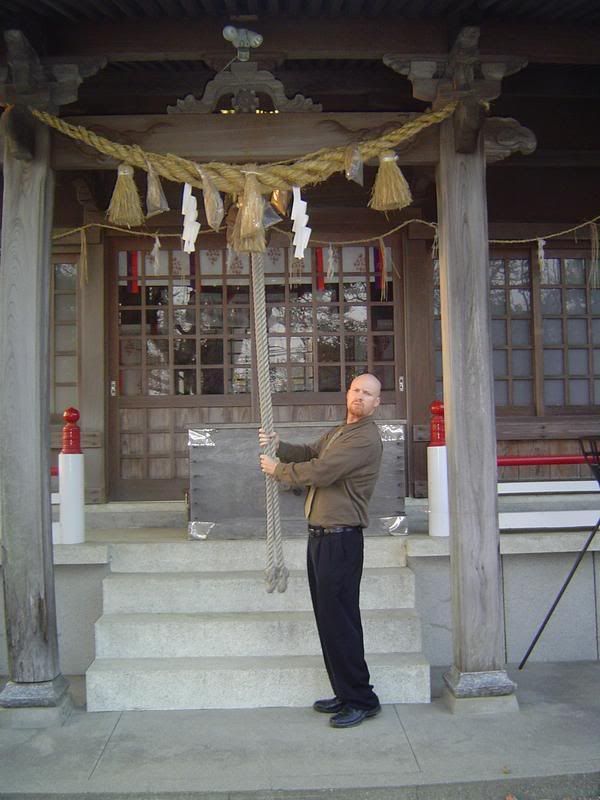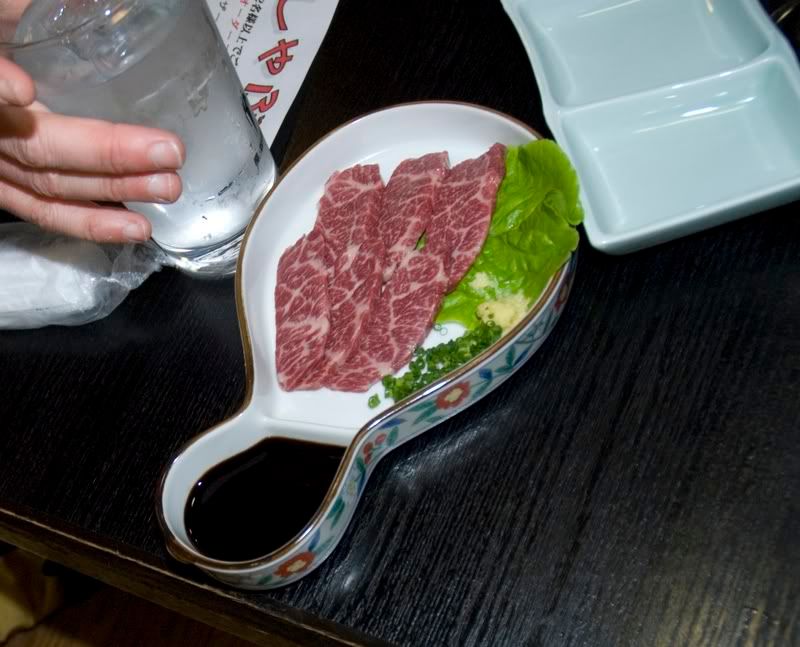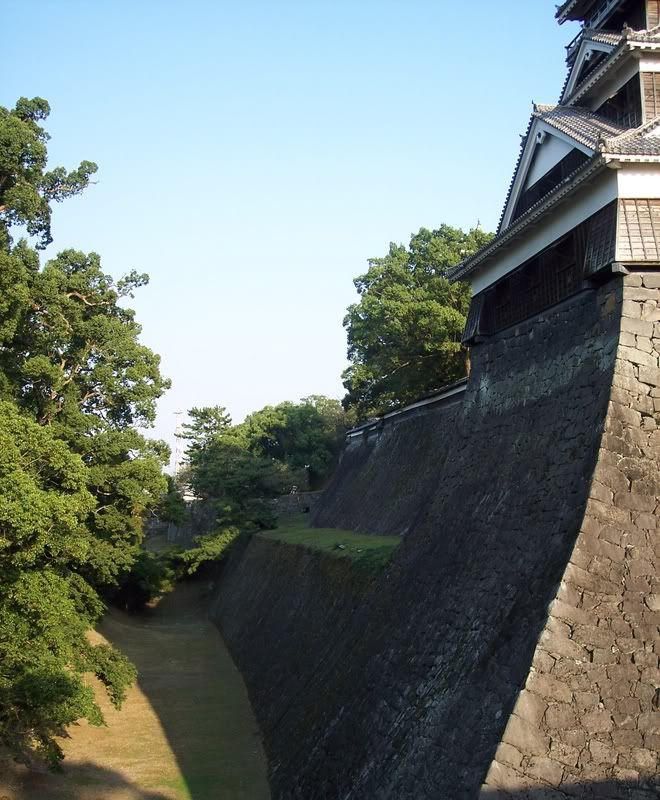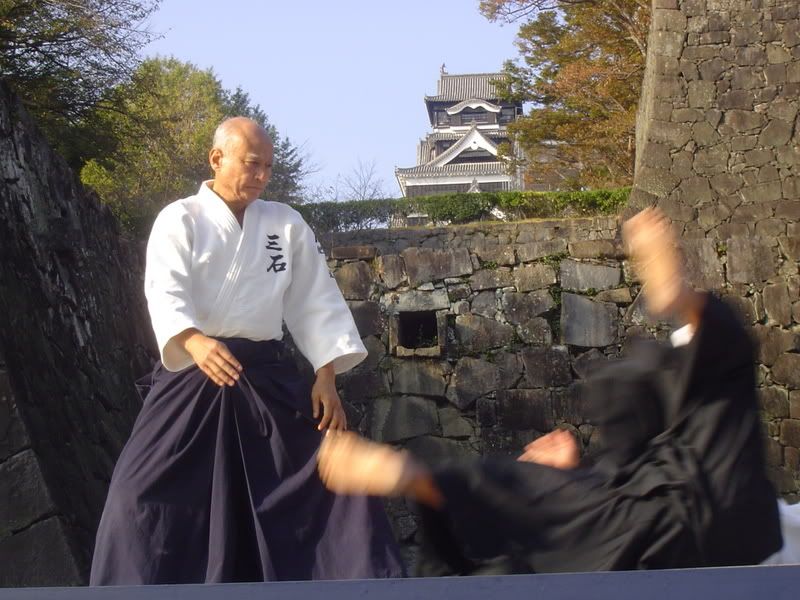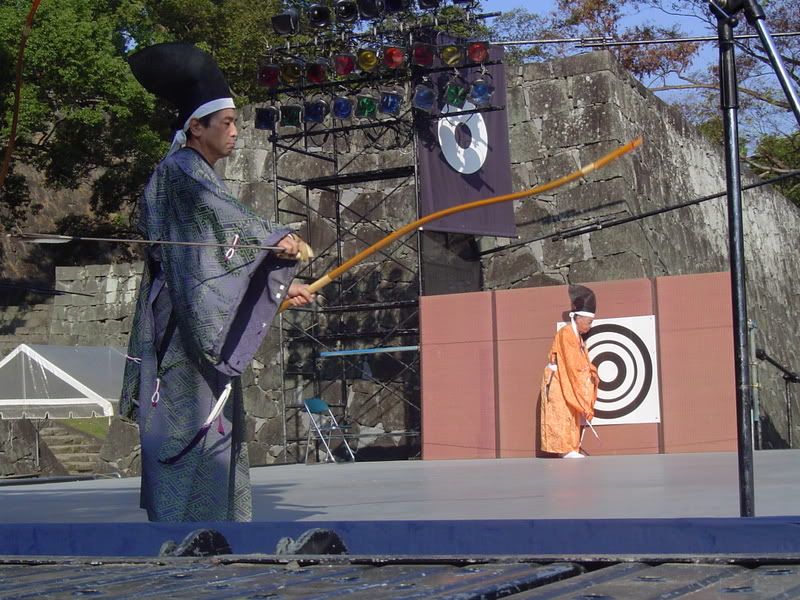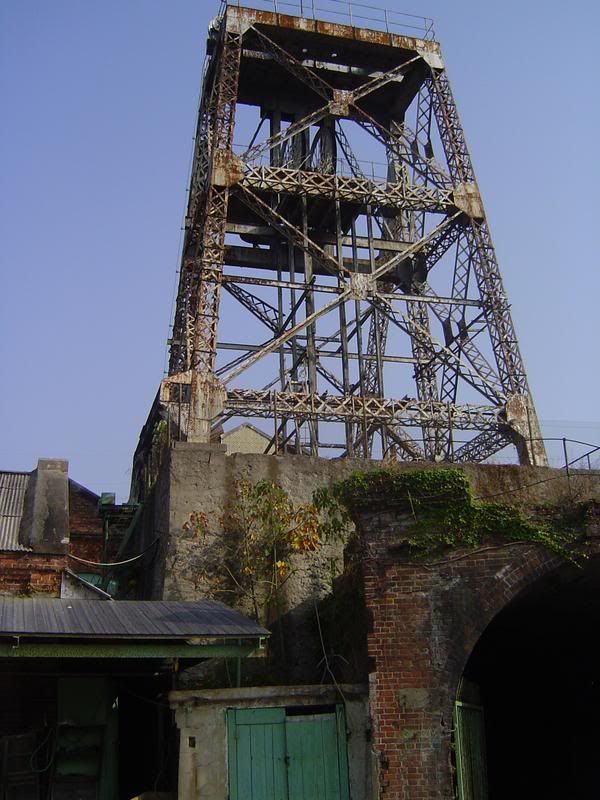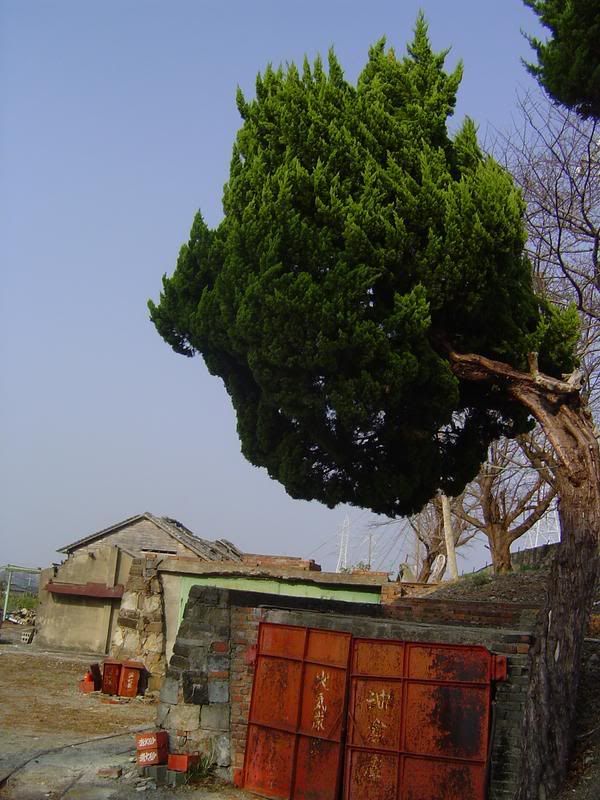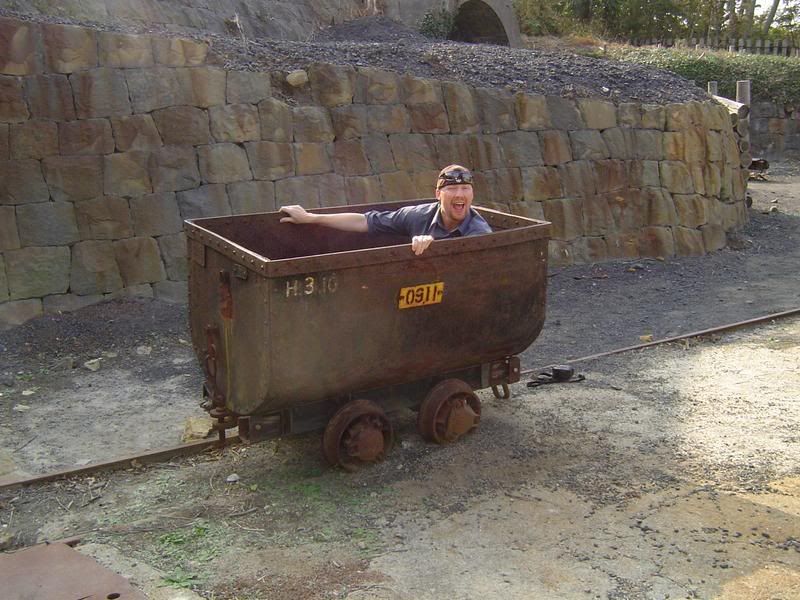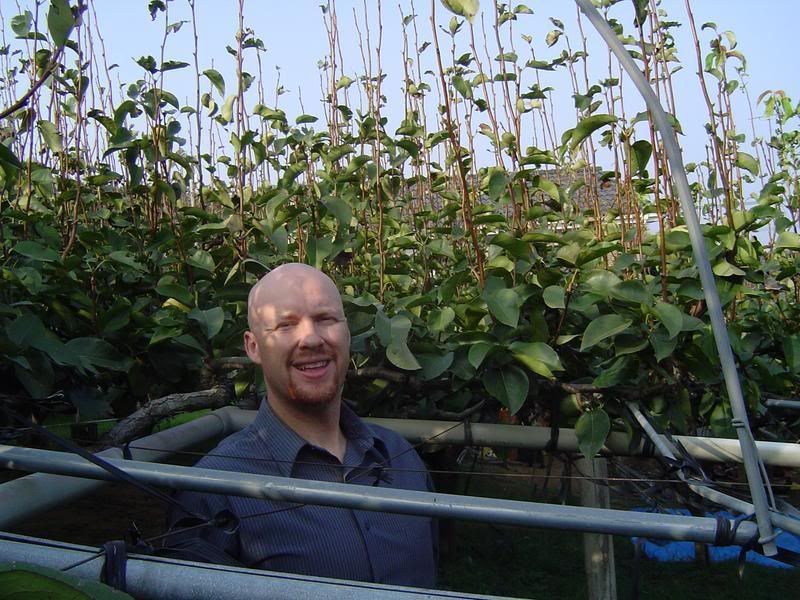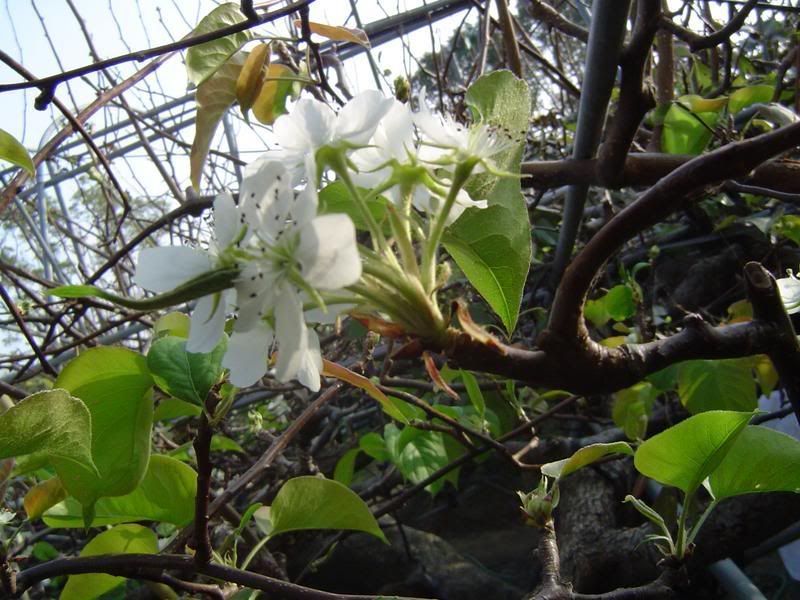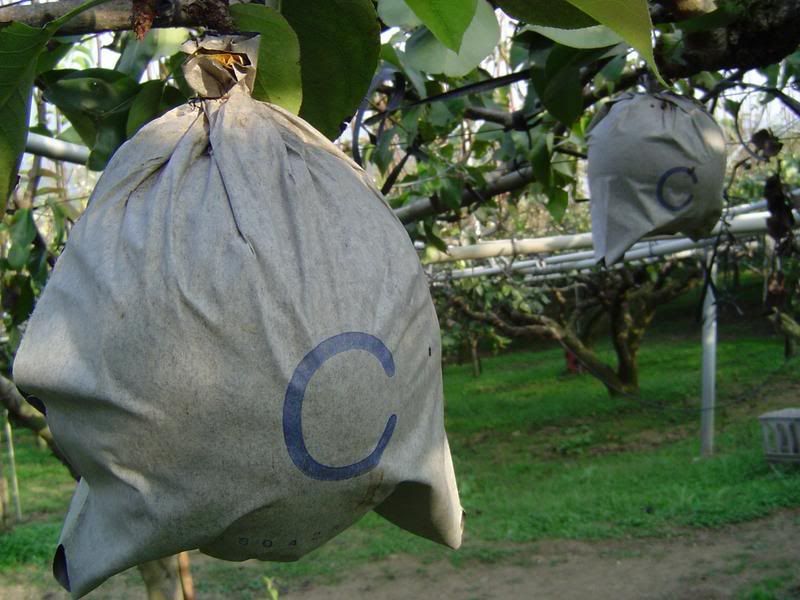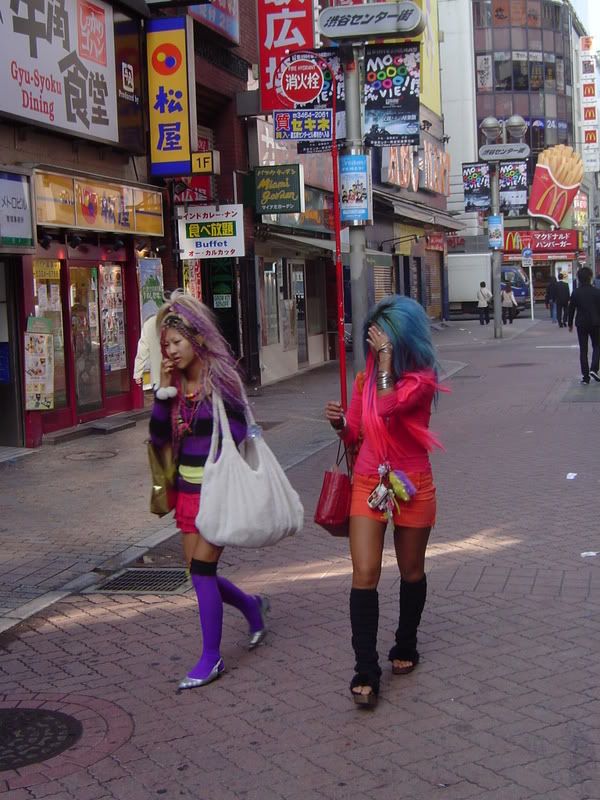10-1-06 Sun, Mon & Tues “The Calm Before The Storm”
Wow – I have sooooooooooooo much stuff to bring with me, but the problem is, I can only bring enough to fit in one small suitcase because there is a size limitation to Japan. QUANDARY… What gets the cut?I am looking in front of me now at two TONS of clothing, a loquacious leather jacket, a dreadfully delightful dress jacket, an old school Run-DMC adidas jacket, a bee’s-knees DVD camera from school, my neat and sweet digital camera, my passport -sporting a styling profiling “bringing sexy back” photo, a luscious laptop computer, a welly web cam, a bodacious bag of gifts including NY City T-shirts and New York Yankee baseball caps to give to the family that will host me, a fabulous few hundred rubber bracelet for students I meet, a thousand goofy business cards written in Japanese, my language map (a menu of key phrases listed for easy access), some styling old yearbooks and course guides from my school, a Japanese/English Dictionary, three precious pairs of nikey sneakers, a crocodile karaoke CD (my favorite), $500 in cash (word up!), a yen-US dollar converter table, $40 for Mr. Boswell’s fancy dancy Japanese soccer whistle request, my 100 yen club wish list of students who want something from the most dominating dollar stores in the world, a pair of headphones for the massive movie I hope that they play on the plane (it is a 17 hour trip out of San Francisco), some various Xena DVDs to pass the time, a few packs of extremely minty gum, an extra roll of toilet paper -and an endearing list of friends and family to write to.What would you cut?
10/1/06 Sunday – “Sunday in San Fran”
Ok. I am off. So far, it has all ready been a little bit crazy. I got to Albany International Airport on time, 5:30 AM (which means I had to wake up at about 4:30). I checked in an enormous super-sized bag that was so wonderfully stuffed it was bulging at the seams. The reason I did not pack two is because The Japanese Fulbright Memorial Fund (JFMF) has a suitcase limitation; one case with a total of 62 inches (length + width + height), one traditional carry on, and one personal item that in this case is my laptop.
Well anyhow, I had a bottle of water in my carry on that had to be moved over to my checked bag at check-in, due to raised level of terrorist awareness from security. Trying to squeeze the bottle into the already tightly-packed case was like trying to fit a monkey into a Kleenex box.
So finally, I get into the longest line I have ever seen at Albany International; now dubbed international, I believe, because we finally have a plane who’s right wing momentarily extends over the US/Canadian border for about three minutes of flight. I wait in the line that moves the slowest, of course and decide to put my Fulbright name tag on. Curiously enough, the woman in front of me was Julie from Schenectady High, someone whom I had never met, but had talked to through email. She too coincidentally is making the Japanese journey and was awarded as I by JFM and the Japanese Government -all expenses paid. Being from Schenectady, she only lives about a half an hour to 45 minutes from me, and we found it kind of funny that two people in such a close radius could have won the three-week scholarship trip.
Going through the security check, I was informed that I had yet ANOTHER forgotten bottle of water in my carry on (which too was packed thicker than London fog.) I wonder how many free beverages the security guys have been able to enjoy since that terrorist scare a few weeks ago? The dastardly man in black took my precious dragon-fruit vitamin water and I was left parched.
Finally making it to gate A-2, rushed a bit due to my second beverage incident of the morning, I was happy to see the ON TIME status below Dulles Washington – United Airways Express. However, the sign was not updated. I caught up with Julie again and learned that there was a problem with the left wing flap. Not knowing planes flapped their wings, I soon learned that a problem like this can hold you up for an hour and a half. This would have been fine, BUT… I had to be to Washington for a connecting flight to San Francisco in precisely an hour and a half!
Let me digress for a moment… I have been fortunate enough this past year to take advantage of a number of professional development trips across the states. It seems being one of the few academic teachers in my mostly vocational school, I luck out and get cool “vacation-site” trips. Last year alone, they flew me to Nashville for “High Schools That Work” Chicago for the ASCD conference and Santa Barbara, CA for a preparatory workshop for a new class that I am teaching called “Pre Tech”.
In returning from my journey to Santa Barbara, the dinky little airport which primarily only flies to Arizona International, got us to the desert airport a few minutes too late. Tom Slovic, a social studies teacher, and I rushed off our blue-light special plane held together incidentally with duct tape and ran down seemingly miles of souvenir, magazine and coffee shops only to learn that our connecting flight home was still in fact there, but had shut their doors. With the 4th of July weekend approaching, US Air could do seemingly nothing to get us on a connecting flight to Detroit, which would then take us to Albany. In desperation, we tried a few stand-by deals, and actually got on one! However, it too was late to Detroit and we ended up having a 15 hour lay-over!!!
Back to Bevan’s journey to Japan… I slept about the entire flight to Dulles/Washington and was awoken by the pilot’s voice telling us that we would gate with about 10 minutes lee weigh to get me on my flight to San Fran.
When I got off that plan, I moved as swiftly as a cheetah. Hopped on a shuttle to the D concourse and found D-8 just as they were shutting the doors.
Julie didn’t make it…
Survival of the fittest. We will have to see in future postings what happened to the teacher from Schenectady. As for me, getting on the plane late had its advantages. Instead of sitting squished between two heavy boom-booms, I took an empty seat in “Economy PLUS” which was $40 more, had plenty of leg space and was WAY more comfortable than if I were to have sat in my regular seat on time.
Sunday, Oct 1,2006 At the Sheraton Gateway Hotel
I checked in. Nice little room. I have a roommate tonight, but will be flying solo for the rest of the trip.
Being Communications Coordinator bugged some people in my group. They thought I work for JFM, but didn’t realize I am the same as them. My only real duties are reporting to the officials and distributing information to our teammates. So when people asked me some “burning questions” and I didn’t have answers, a few faces looked angry as I wrote the questions down. Oh well… Give a group of people a free 20,000 trip and they will still find stuff to bitch about.
I found Laurie from Schenectady. She did in fact miss the flight, but thanked me for trying to get the gate keepers to hold the plane for her. I guess they told her I tried. She missed ALL of the orientation and rolled in around 6:30, just before dinner.
I met up with my group. There are three or four of us who kicked it off pretty well. During dinner we talked about silly stuff we had read about on the Internet like eating “basashi” (raw horse meat) and “kanchu” an Asian wedgie-like prank that is rumored to be all over Japanese television and schools.
A cool panel of old JMFers showed some digital pictures and talked about what to do. I will definitely staying Tokyo for my free time off now I think.
10 – 2 & 3 – 06 Monday & Tuesday, “Crossing The Line”
1st day –Monday & Tuesday, Oct 2-3, 2006 “Crossing The Line”
Flying into San Francisco the other night was a great move by JFMF. First we had a nice little get together and an orientation, followed by some great food and a good nights sleep before the plane ride. Being fully rested would be the key to success after such a long trip.
I got up at 6:AM and ran about three miles, knowing that I was about to take a monster of an airplane flight. It was a small little gym with only four treadmills. They were full, but I only needed to wait about 5 minutes. Some guy next to me REALLY needed to brush his teeth, but no silly American was going to wreck my glow coming from the opportunity of a lifetime.
After a quick buffet style breakfast, I made it out to the bus and found that one of the JFMF guides was wearing a hat that ooked suspiciously like mine! I had left it in the dinning room the night before. She gave it to me and we all laughed.
We took the shuttle to San Francisco airport and the entire bus load of JMFers waited in line to have our passports checked in a special line made just for JMF. We got our tickets.
Next, I ran around the entire airport in search of one thing; the one thing that I had forgot to bring with me – PANTS. That is right.
When you are in a hurry, it is very easy to leave a stack of clothing on the table and walk out the door. I had PLANTY of pants ready to go. But they were back home in Albany and they were doing me no good in San Francisco.
I only had shorts with me and a pair of jeans. This brings about two problems… ONE – In japan pants would cost a ton of money if I could find them my size and TWO – I would not find them my size. Everyone is like a size 29-32.
No luck in the airport. They had EVERYTHING, but pants.
I got on the plane for my 10 and a half hour trip and watched bits of the new Poisidon movie and also watched some episodes of Twilight Zone with a cool art teacher sitting next to me on my laptop, (Jenny Sodo from California.) She is pretty cool and very into music. She tried to charge her ipod off of my IBM computer and it locked up, because the two, IBM & apple, were not compatible I guess. But it has since corrected itself, though she had feared my computer killed her iPod.
At a strange part in our flight, it got really dark then light again. We passed the international date line. It was a new day. It was pretty cool to watch the monitors that were embedded in the seats in front of us. They had a map of the world and we could watch our progress as we reached the line and then later our destination.
As we got off the plan, we found ourselves exhausted, because we had added about 13 hours onto our day due to time changes. We had our passports looked at and then were escorted to our shuttle.
On the shuttle, I helped distribute to my group 260 yen for meals along with maps of the city.
Jen, Andrew and I went out for a walk in Tokyo. Andrew met up with a couple of friends who wanted to eat at a sit down restaurant, but I was a bit too shot for that; coupled with the idea that eating at 8:PM was like actually eating at 7 AM Eastern time – AND I STILL HADN’T SLEPT!
Jen didn’t really want to eat either so we stopped at a convenience store, grabbed a couple of strange drinks and headed back to the hotel. The drink I got looked sort of like watered-down mercury. It actually tasted like coconut and lemon, or at least something close to that and had an after taste that I had never experienced before. “Calpis Water: Refresh & Happy” is different. I didn’t dislike it, but it is definitely an acquired taste and one I had never acquired in America before.
Just as we got back to the hotel, we found a cool little Japanese garden so we decided to go check it out. In it was a little pond with coy fish and many bonsai trees. Jen saw a stray cat and went over to it, so I took a picture. It was a funny looking thing, in that it had virtually no real tail.
When I got back to my room, I hit the bed and was out like a light. I woke up a number of times though during the night, due to probably jet-lag.
In the morning I realized that I had NO toothpaste. I called housekeeping and they said that they could bring me up some in 15 minutes. As I took a shower, I got another call saying it would be more like 30 minutes before they could bring it. When It finally arrived – the man handed me a toothBRUSH – not toothpaste. I thanked him and then brushed my teeth in the remainder of the Calpis Water from the night before. Speaking of things that I forgot, I FORGOT ALL MY DRESS PANTS IN ALBANY, remember? I am now known as the guy who has no pants in the JFMF group. Fortunately, one of the other members said that I could borrow some off him. He brought me a pair of khakis that were WAY too big for me. I may still wear them a night or two, seeing as I currently have nothing, but I do look like MC Hammer when I have them on.
10-04-06 Wednesday “Traditional Kabuki & Tossed Cookies”
WEDNESDAY, Oct 4th “Traditional Kabuki & Tossed Cookies”
I just woke up and tried on those loaned pants. What was I thinking? I cannot wear them. They are WAY WAY too big! Back to the jeans.
Today we had a great breakfast and listened to a cool speech about how the Japanese student population is starting to mirror some problems that we find currently in the states. After the speech, we had a great lunch with some Japanese cuisine and some other foods from around the world, served the best way in the world: BUFFET STYLE.
After lunch, our group went out to the Japanese Garden behind the hotel and got some great shots. One thing that was quite interesting was an ancient Japanese style bridge over a stream. In it were hundreds of coy fish, who I believe were now somewhat domesticated, due to hotel customers feeding them. Though no one was feeding them, I came up with this theory because the fish would swim right up to you and let you touch them. Looking like large gold fish, they were very beautiful and I had Victoria from our group take a photograph of yours truly trying to kiss one on the head.
Next, JMFM had two hours of traditional Japanese theater with annotations, questions and a history lesson. The first hour was Kyogen Japanese theater by an American performer named Don Kenny. Kenny performed this ancient art form exact with costumes, lines and style. The only thing he differed in was language so that we would understand the story. Kenny explained that Kyogen is very slow deliberate execution of each line. The dialogue is drawn out and choppy and seems strange that thw words are spoken as slowly as they are. The quick play had a villiage idiot (played by Kenny) going to a Sumo’s place and challenging him to a fight. Most Kyogen plays are perfomrned with 1-3 actors and the actors were theater masks much like ancient Greece. Kenny allowed us to photograph his masks. There are typically only five masks or so used in this performance art; a devil, the God of Happiness (a smiling Japanese man’s face), the younger daughter, the heavyweight older daughter that no one wants to marry.)
The second art form was “Kabuki” theater. This demonstration was brought to us by a Japanese performer named Mark Oshima. Oshima had a very interesting PowerPoint that covered the different eras that Kabuki has aged through. Kabuki theater can have many actors and is often done with an elaborate set and some very elaborate costumes and face paint. This art form is often musical with most actors singing their lines. The Japanese in this art form use a small ensemble to help express the mood of the story including a solemn sitar that helped to express the pain the female kabuki character was expressing.
During the performance of the history, a woman Kabuki actress showed us how she does her make up live on stage while the Kenny took a host role on and. This particular story had a sad subtext going on during her dance –stating that the Kabuki had lost her boyfriend. The singing was close to a lamentation at times and Don Kenny explained that a strange phonic lead was used; something that sounded like a fast high pitched A-E-I-O-U was sung at the end of words/lines to keep prolong words ( the style sung in) from blending in together and sounding like some other big word/phrase which could very easily well happen in the Japanese language.
I filmed this on my schools mini-DVD recorder along with Virginia, a TV production teacher in Miami. She is going to take my footage and inter-splice it with her own, to later give me an edited documentary of the trip.
With a two-hour break before our reception, I went and found the gym and was able to run about two miles – OR SO I THINK! A few words about the gym; it looks as if the Japanese don’t use the gym much, maybe it is a provision allotted primarily for westerners, though I am not certain. I say this because our hotel is HUGE, but there is only one treadmill, a couple of bikes and a pad. Another odd note is that the treadmill’s means of calculation and measurement was calibrated in meters, so it confused a stupid guijin like me.
For our reception & dinner a few JMFer alumni spoke about the importance of the program and how it has lasted for ten years now, even though they believed it would dissolve after completing it’s original five year vision. A toast was given by the former mayor of Minato City, Keime Haarada. I actually drank most of a red glass of wine, due to the fact that I did not want to insult the waiter who poured it for me who stood right near by. Once dinner began, buffet style again (I love it, but might get fat after 3 weeks if I don’t keep at the meter treadmill.)
It was a stand up dinner in the same place that they held the reception. That means no chairs and a few stool-like tables. We had a number of good dishes once again. I particularly enjoyed some Japanese beef strips and the pork tempura. There was also another good dish called John Dori – a fish in sauce that was particularly good.
On the way back to my room… GET THIS: Jenny, Meg and myself were in an elevator with an Indian woman. We were talking about the reception and not really paying much attention to anything when all of the sudden, the Indian woman turned her head and barfed on my only pair of pants!!!
She apologized, but the damage was done. I was gooey. When we got to floor 35, I was thoroughly grossed out from the repugnant act that was just bestowed upon me. Jenny’s room was a little down a hall and right in front of the now overly juicy elevator. Thank god, she went and opened her door so I wouldn’t have to touch anything. I had a big glob of “Double Dare” slime oozing off of my arm and hand, as well as a sizable helping of up-chuck on both my hip and pants.
Jenny described the situation by saying “it looked like the woman was just dumping water on the floor,” and that she didn’t have a clue what was happening at the time that the lady lost her lunch.
I cleaned off the yak the best that I could and hurried back to my room to soak my jeans.
After dinner Jenny, another art teacher, and a few social studies teachers went over to the pachinko area. Pachinko is a casino like game that looks like a cross between a slot machine and a pinball machine. You play it to try and win these little ball bearings that you can trade in for a metallic bar. Now here is the trick: because the government does not allow gambling, you play for a metal bar that can be traded in for a ski-ball type prize like you would get here on a beach –or- you bring the bar out to a side alley and trade the bar in for CASH. This loop hole allows for gambling and the ski-ball type prize is, for the most part, a front.
We got a few shots of the Pachinco zone. The typical pachinko hall is an obnoxiously loud place with flashing lights buzzers and bells blaring constantly at the highest of decimals with lame jingles and chimes to boot. It is a very campy smarmy area with lots of bright pinks and light blues and it was quite a surprising contrast to see that primarily it was packed with Japanese business men in sharp professional nice suits. Also in the pachinko area, we saw a Japanese McDonalds featuring the new “Filet-o-Shrimp” sandwich, a book store that had a naked tattoo book in the children literature section, and a grocery store featuring some kind of alcoholic beverage with a goat testicle in the bottle. Trying to take shots of all the different things we see can sometimes be difficult. We tried to get a shot of Jen in a psychedelic hallway of some weird restaurant you can only get to by taking a few flights down into a basement. We did get chased out of a funky hallway for taking picture.
10-05-06 Thursday “The Big Rush”
THURSDAY The Big Rush OCT 5th
We started again with a nice breakfast. I talked to a guy that some of us are now calling Indiana Dan, because he wears a pretty nifty Raiders Of The Lost Arc-like hat. Though he might look like a killer from an outback, he was really cool. He talked a bit to the others at the table about his job of trying to work meaning into students’ life where you actually apply critical thinking skills to workplace settings. It is always nice to chat with some educators. I love ripping off ideas. He inturn enjoyed hearing about our integrated English program within our CTE (trade) classes.
Next we went on a bus tour around Tokyo. The sheer enormity of Tokyo is staggering. About 12 million people (10 percent of Japan’s population) live in Tokyo, but you don’t see the ridiculous traffic problems like you do in say a NYC. While Tokyo’s subway and commuter railway network are the busiest in the world, it is relatively easy to get around.
Tokyo was designed around the turn of the century to be “rail-centric.” Construction was actually centered around major train stations in a high density fashion so large amounts of people would be able to get where ever they wanted fast and inexpensively. I learned from the tour that this differs from other world cities such as LA that were designed at a low density of human traffic and was laid out to be automobile friendly. By making mobility so much easier, one would gather that more businesses moved to Tokyo, which made a demand for more people to live here and subsequently increased population.
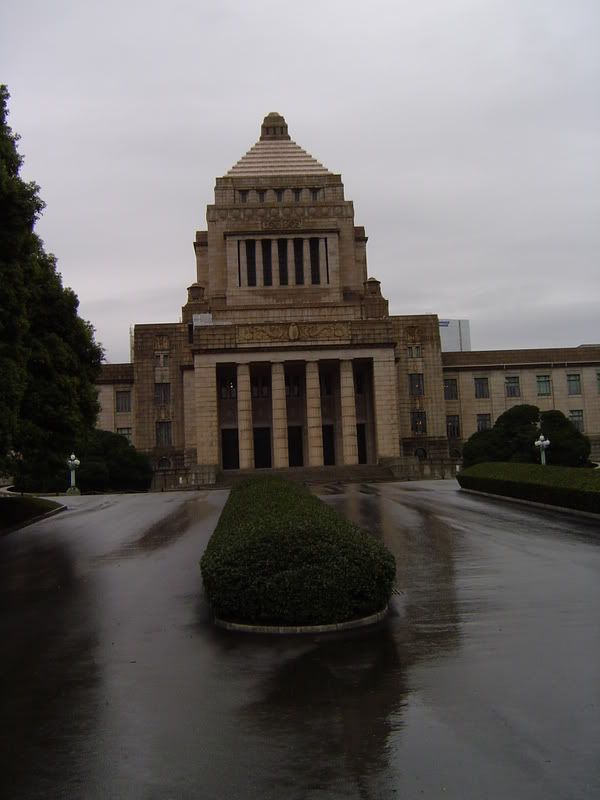
One of the first cool things that we saw was The Imperial Palace of Tokyo, but we only really rode past it. Our first real destination was “The Japanese Diet Building.” With a name like that, you would think that this place was a huge building filled with fish and Saki, but that was not the case. The Japanese Diet is similar to our House of Representatives. It has 480 members each term (since 1996), who are all elected on the same day for a stay of four year terms. The building was elephantine and we walked through with a tour of school students.
Outside the building was also a beautiful garden representing much of Japan’s most beautiful types of trees and plant life.
Our next destination was a stop to the Asakusa Temple & Shrine. At the Akasakusa Shrine, there is a famous fortune box, where people take fortunes out of little drawers. I went through the ritual and it told me I got fortune number 37 I believe, entitled appropriately for me “The Best Fortune.” However, a woman that I was walking with from our group named Victoria, a TV Production teacher from Miami, pulled “The Bad Fortune.” We learned however, that if you receive a bad fortune, all that you needed to do was tie it on a rack of strings, and the gods would make it go away. (Victoria was as quick as a cheetah to tie hers off so her house would not be destroyed.)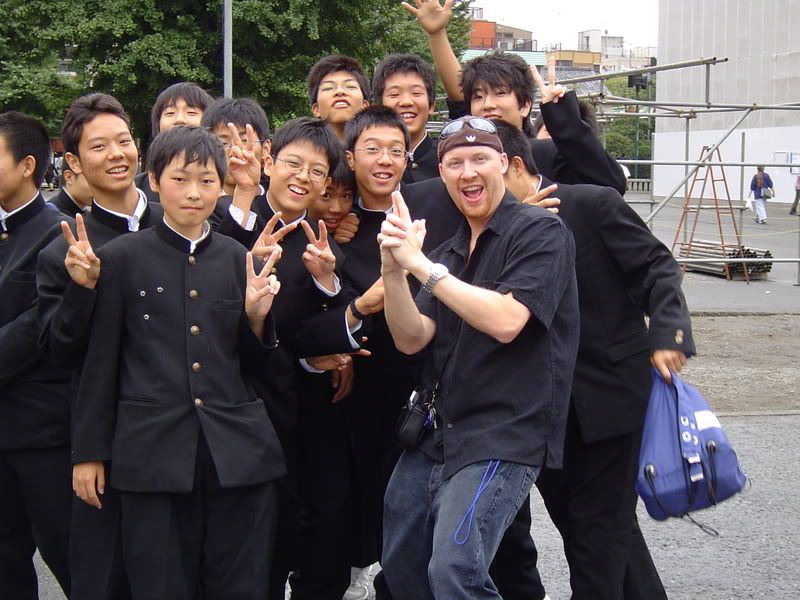
Aside from a number of tourists and other visitors, the most interesting thing about this is temple yard was the water purification statue and the Asakusa smoke pit. 
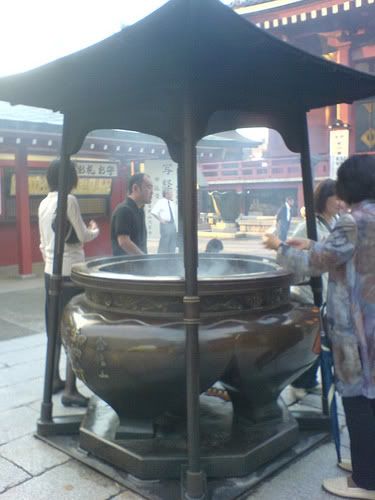

The water purification statue was also a fountain where people would take water from little brass cups on poles and purify body and soul before entering the temple. The way one would do this is to touch each one of their wrists to cleanse their body, then rinse their mouths out and spit away the evil to cleanse their minds.
On the way to our lunch, we walked down a series of vendors selling candy, clothing, toys and other souvenirs. At the end of the strip was our lunch, a traditional Japanese restaurant located right in front of the Asakusa Shopping center. We waited in line and walked up a staircase. At the top we removed our shoes and put them into little baggies to retrieve later. Lunch was a very delicious Tempura assortment with lightly battered jumbo shrimp, peppers and something that reminded me of a Chinese dish like an egg foo young, but not as moist and more vegetable oriented. It was very relaxing to sit at the eastern setting before me, on the floor and take in such an alien but appealing site.
We returned to our hotel and were treated with four hours of speakers. As I was entering the hall, a JMF staffer told me that I could not enter, due to my JEANS! Eventually I was able to persuade them, however, I was told that I was NOT to stand at any cost during the speeches. Stupid gii-jin. (Dumb American.) Takahiro Miyao (pronounced “meow” like a kitty says) first gave us an exciting speech on the economic statud of Japan. In the hour and a half in which hhe spoke, I learned that Japan has lost a considerable amount of money in the market place over the last 15 years due to a High Budget deficit, a HUGE Social Security Burden (due to the elderly living so long) and a lack of innovation. It seems that Japan, while it does a super job manufacturing technology, is not very good in innovation; creating new products, rather than making old ones better.
After Yuji Yshima (Diet member), Hiroya Ichikaw (Professor of Sophia University and Kuniko Inoguchi (Cabinet Minister) spoke with us for a few more hours, I was ready to crash.
The last speaker was actually pretty cool and made us feel like we were in Oprah’s audience. She presented to us samples of Kenji Miyazawa’s works; an author of Japanese literature.
So by the time I got back to the room and was just about ready to crash, I was scooped up by Latina shopping guru Virginia of Miami. I wasn’t all that interested in shopping, however, I NEEDED PANTS. So a group of us went out in the pouring rain to check out The Asian Exchange and an upscale American thrift shop called CHICAGO. Most of the people in the group were hoping to buy stuff that looked like it came from Japan, because almost EVERYTHING for sale in Tokyo seemed to have English text on it all. (You would not believe how many people sell NY Yankees stuff.)The Asian Exchange was closed and just like Tokyo, there were no pants that fit me in CHICAGO.
The shopping spree was not a total failure, however. I made it to a 100 Yen store. These types of shops are much like our own “dollar stores”, but with better stuff because it is manufactured locally or nearby. I picked up about thirty pieces!
So at about 9:30, after a long day, I was starving so I suggested eating at a Japanese McDonald’s. And guess what I got? The Filet-o-Shrimp!!! (It was actually pretty good, topped with some kind of sweet dark brown sauce and something that wasn’t lettuce.)
Sianora. Train back to The New Otani.
10-06-06 Friday “Fish Market Madness”
FRIDAY FISH MARKET MADNESS
The day started at 4:00 AM for me, before the Tokyo Metro subway is even in operation. I took a cab with three ladies, whom I had not really met, being as there are 180 people not in my group of 20. For the most part, I have been hanging with a few really cool people I have met from my group; Andrew, Kip, Jen, and Virginia. The difference today was that Kip & Andrew left the hotel somewhere in the area of 2:45 AM to see the Tsijiki fish market WAY WAY early. I was shot and settled with sharing a ride with some people I didn’t really know.
Cab ride. We hopped in a taxi that was “all tricked out” featuring computer generated navigation maps with the works. This had been my first real experience in a Tokyo cab and for those of you who have not really driven on the other side of the road, you feel like you are in danger the whole time, until as they say “you get used to it.” I am still not used to it.
Rain. Our driver spoke not a syllable of English but did bring us relatively close to the market with the proper prodding. The road was lined in street vendors near the three miles of warehouse, but we didn’t know that where we were wasn’t the actual market itself. After not seeing any signs of an auction site, the vet teachers decided to follow me. So my first move was to venture out into the tail end of what I have since learned was a monsoon.
Pouring boatloads of water on us, I acted as the communication specialist for the wavering women cowering from the elements. Asking a number of vendors “Fish, dokko desku?” my common-placed inquiry eventually led our little group to the shocking Shangri-La of tuna.
The warehouse weave began about 5:00 AM, after about a half an hour of searching.
When you first enter Tsijiki, it is a blinding white blur of Styrofoam boxes. For as far as your eye can see, merchants package fish and other friends of the sea into little plastic caskets. The merchants set up shop right there on the spot; the very same spot that live fish are slaughtered and diced and turtles are beheaded.
Essentially, Tsijiki is a Japanese version of a glorified American slaughter house, with the exception being we do not invite our customers in to witness what it takes for a cow to become a double cheeseburger.
After walking through about two warehouses of vendors, we finally made it to someone with a map. The warehouse worker was very friendly, although we were probably the millionth visitors to ask where we should go. He spoke no English, but easily directed us to the public visitor section.
We opened a door to a divided off section and marveled at fantastic rows and rows of gigantic frozen fish. The icy steamy fish from what I understand are the fish from the last previous days that did not sell in the daily fresh auctions of one particular fish company. There were a number of large areas divided off like this one, meaning the market had a few main fish companies that wholesaled to the many many large distributors, who in turn would sell to the vendors who could not afford to buy such large pieces.
“Flash” freezing is done to kill possible parasites in fish that are to be served raw. Many companies will want to buy the fish afer the have been frozen so that they do not have to go through the process.
For freezing purposes, the sections behind the heads had all been hollowed out. Men hosed down some of the fish to better show the coloration of the fish. They also cut off the tails with hatchets so that buyers could examine the quality of the fatty meat; more expensive and relished by the Japanese for high end quality sushi. They had also at some point skinned back a flap just above the missing tail to see the color of the interior meat below the skin.
I began to lose parts of my curious party about this time and moved out of this warehouse to the live fish section of another. For as far as the eye could see, lines and lines of blue bins held thousands upon thousands of live swimming fish, jumping out of the crammed cages from time to time, seeking more space due to there lack of allotted space. IV-like tubes oxidized the water to help the fish live longer. Some bins were so full that the fish could barely move.
As you should probably guess by now, the Japanese are all about eating the most fresh food possible.
It was a little upsetting, but again, so would seeing how a butcher makes his livelihood. While living conditions during the time the fish were dispensed from half pipe slides that came out of the ceiling are not the greatest. It would not be long before these fish would be in the bellies of many Japanese all across the country. An English speaking person said that 95% of all the fresh have been consumed by the same time the next morning, Then “it all starts over again.”
Alone, I crossed my way back to the frozen warehouse where I heard a bell ringing and a whole lot of commotion. I didn’t realize before that the frozen warehouse was situated very closely to the daily fresh auction, roaring to go on the dot at 5:30am.
“What in the hell is that? A whale?!”
“You could probably fit two or even three of me easily inside the belly of some of these suckers!”
Just a couple of thoughts entered my mind about how different a world I felt like I was in at about this time. The black and shiny tunas weighed any where from 400 pounds to a few thousand. Stickers were being slapped onto fish indicated which fishing company had caught them for compensation and also starting bids. With a few hundred swarming about this warehouse room, about the size of a fourth of a football field, a few guards indicated to the 15 or twenty onlookers (who were obviously not there to buy) that they had to stay in the garage-like doorways.
Watching the people bid on the huge fish was a little bit like watching the stock market and Gilligan’s Island on TV at the same time. They did their thing with no concern or interaction with spectators. This is a daily ritual of their lives.
I caught up with a cool Social Studies teacher from Washington DC and asked him if he had seen the live fish section. He had not so I walked him over to the area and watched his jaw drop. Journeying back even further than I had before, we made our way to an eel tank, just before the edge of the loading dock that led to water and a few boats.
It was amazing just how friendly the warehouse workers were. One took time out of his schedule and posed for pictures with me. He pulled an eel out of the tank with his hand to show me its teeth. I said to the other teacher and a woman who had made her way over to our little eel tour, “I wonder how many times a day these guys get bit.”
After a wet dodging between various warehouses, and a final peek through a farmers market like warehouse, we made our way to the subway and back to the hotel, just in time for a western and eastern buffet style breakfast.
The western featured eggs, bacon and sausage, but I really wanted to try some eastern cuisine…yes…FISH!
I looked down at my plate at a slice of salmon smoked and seasoned and had a better understanding of where it had been maybe only a day before.
Later on, after a quick shower to remove my aura of fishiness, I went to the Women in Japan workshop. In so many words…not very interesting. What I am learning is that numbers are EVERYTHING to the Japanese. In America, we think a great speaker really helps us make a connection to what they are trying to express to use by illustrations. We crave little anecdotes that we can relate to and better help us understand a context. Here in Japan, everything is a percentage, a pie chart or bar graph to get a point across.
10-07-06 Saturday (Part 1) “Saturday Morning Sumo Wrestling”
SATURDAY, Oct 7, 2006 “Saturday Morning Sumo Wrestling”
Sumo is an ancient sport dating back about 1500 years. In fact, according to a Japanese legend the entire beginning to the Japanese race depended on the outcome of a sumo wrestling match. The supremacy of the Japanese people on the islands of Japan was supposedly established when the god, Take-mikazuchi, won a sumo bout with the leader of a rival tribe. The Japanese then had free rights to the islands known as The Rising Sun.
Sumo wrestling is all about tradition, honor and respect and even has religious roots. Early sumo matches were a form of ritual dedicated to the gods with prayers requesting a rich and bountiful harvest. This much like the evolution of Greek theater praising the god of harvest and wine Dionysus. Both in fact were performed together with sacred dancing and dramas within the precincts of the shrines and temples.
Professional sumo groups were later bastardized and created as businesses to entertain the vastly expanding lower class. It is then that sumo came into its own as the national sport of Japan. The present Japan Sumo Association (JSA) has its origins in these groups that were first formed in the Edo Period back some 400 years or so ago.
As my independent study day, the only real “free day” we were given in our busy schedule by the well-organized itinerary of the JFMF experience, I wished to see sumo wrestlers of the Japan Sumo Association in action.
It has once been said that news travels like brushfire. By mentioning my plan for Saturday morning to one or two people, suddenly it seemed like EVERYONE wanted to tag along on my Mecca. This alone would have been fine, but I was afraid some were interested in part, for nostalgic reasons, and perhaps a good laugh.
It felt like we had accidentally leaked out to seemingly the entire group that we were going to go check out the Sumo situation in east Tokyo. And that this leak could jeopardize the visit.
Knowing that even though sumo is out of season in October, I knew that there had to be a handful of sumo gyms that continue to train (and feed) their wrestlers to help them stay in shape for the next season of competition. So after some talk with the consieere, I was able to locate one gym that would allow me (and “a few guests”) to attend a training session.
The hotel was able to get us a free visit to The Kokonoe Beya Sumo Dojo in the Kinshicho-ku. (Putting “Ku” at the end of a metropolitan area means “ward” or “section”.) While Kinshichu was not the world famous Ryogoku, home place of all major sumo events, it was in fact very nearby.
The only condition was exactly what any fighting facility would request: that my guests and I stay respectful and silent during the meet, so as not to distract the fighters from their workout.
As the days went by in Tokyo, many of the JMF’ers would ask “so what are you doing on your independent study day?” After my response, randomly many said they wished to come along and would seek further discussion from the consieere. This worried me a bit, as I pictured enormous groups showing up at the foot of the gym and being turned away.
Never-the-less and hoping for the best, Kip, Jenny and myself decided to school ourselves in the art of Sumo so we got up at the giant butt-crack of dawn to go check out a sumo dojo (training facility) in Kinshicho, about a few stops away from “Sumo City” in Ryogoku and on a different metro line.
Worrying about others destroying my independent study day was not entirely widespread. If any one else from the Arao group wanted to tag along, at this point I would have encouraged it. We are for the most part bonding and becoming good friends under the common prefectural banner of Kumamoto.
At 5:50 AM in the tower lobby of The New Otani Tokyo Hotel, we literally met in the land of the rising sun, under the rising sun. There was another group of about five there who said they were now going to see the same sumo wrestlers that we were.
Because there had been a number of people telling me the different times that they were heading over, I still wasn’t sure if a problem would occur or not – due to staggering times that the sensei must have been allotting. It felt like everything would be okay. Therefore, our group of three rushed through another delightful western/eastern breakfast buffet and headed out to the street.
After some discussion of which metro train to take, we found the right sub station across the street from the one we had been accustomed to taking and took the Honomozin line to Kinshichu, following a little purple line on the map.
Rule of thumb; if you are trekking through Tokyo, you are going to get lost.
We made it to Kinshichu, walking out of the subway and into a real long sand and tree covered however, once we got there, we followed the rule. We had absolutely no clue where to go. We had a map that the consieer had given to us, but we couldn’t read a word of it. We talked to a number of people and found that directions were virtually useless, but simply having them point in the correct direction helped tremendously.
Eventually, we showed up. I knew we were in the right place, due to the countless Tsijiki fish market Styrofoam caskets piled up outside a door. (Sumo wresters can EAT.) We peeked in the door and a sumo wrestler nodded and motioned for us to go to the front of the building.
It was about 7:45 in the morning. In the front of the building, I stood and posed in the doorway by a beautiful copper bust sculpture of a sumo wrestler. I took a breath and entered the unknown.
We walked up a very wide foyer stairway with some trophy cases, sculptures and various photos and pieces of art. An awkward occurred in the hallway for about two minutes. We could hear the training going on behind a sliding door, but no one came to welcome us or show us in.
Knowing that it could be offensive, I was very careful to open the door and peak in.
Inside about eight people (a few members of JFMF and a few not) sat intently at a very very large clearing on silk red pillows observing the intense training before them. Because of the layout, we felt comfortable in joining in on their watch.
The room was a giant square divided in half. The dichotomy consisted of a spotless stage-like viewing area for spectators, decorated in beautiful sculptures, awards and artwork, and a step down into a dirt floored fighting pit, replete with a regulation sumo circle, a drinking bucket by a sink and two rows of towels.
The pit’s circle was directly centered and lined in straw roping staked in the ground. It looked like a clay footing, much like you would see on some tennis courts, but topped in loose dirt for help in leverage.
The way that the sweat and soiled sumo wrestlers were training as we took our silken seats was one fall king-of-the hill. One wrestler would spar against another and throw his opponent out of the ring. The moment he defeated the other, a number of new challengers would run toward the winner and put out his hand and say something that sounded like “Highs!” This would indicate that they wanted to be picked for the next spar, which would take place immediately in the circle. The winner of the last fall would then touch the hand of the challenger they wanted to take on and the circle would be immediately cleared of bodies for the next fall.
We watched for about an hour and a half and learned a great deal about this particular dojo. The sensei stood to the right side of the ring, close to our stage. He spoke only two or three times at the very most.
Everyone seemed to be allowed in on the king-of-the-hill spar, except for two. These two were rookies and though they were in full gear, they were not permitted to participate yet this early in the game other than partaking in warm up techniques as they watched the others.
One rookie in particular, who I wall call Hairy for obvious reasons, for two hours straight stomped his feet to increase his leg strength for balance. I am sure you have seen this before; a spread eagle stomp and squat combination that goes hand in hand with the sumo wrestler stereotype. This is what I have learned to be called the “shiko approach” of ritual foot stamping.
Because we as spectators were not able to speak to the largest athletes in the world standing before us, we have no idea what any of the sumo wrestlers and students (soon to be sumo competitors) call themselves. So, for lack of a better name, I will call one “Poofi” (because of his poofed-up poofy Japanese mullet hairstyle) and the other “Hairy” (because the amount all over his back.
Another seemingly new student to sumo point of interest I will aptly call “Chip,” due to his ridiculous lime green out-of-place Walt Disney Chip-n-Dale towel that he sported so gingerly.)
From my understanding, some wrestlers will go a number of months simply observing before they are allowed to participate. Newbies get into gear and hope that “today might be the day” and that the sensei will tell them to jump into the mix. Some times this day could take days, weeks or even months to come. And for some, this day may never happen.
One rookie, Hairy, on this particular day was in fact allowed to participate in a push drill, where selected wrestlers by the sensei would charge a wrestler and have to slide his target a full length of the circle (4.55 meters in diameter.) The target would lock his legs and allow his feet to glide across the dirt floor until his heels hit the other side of the circle. Hairy wasn’t bad at this drill at all, but Chip was pretty terrible.
It seems as Chip had paid his dues and attended a number of training sessions, so now the dojo was testing him out. He was very disoriented, very unsure of himself and the only on the sensei stopped to talk to during the training. He was kind of geeky in a way and not very agile. He wished to be tagged in after every spar, running to the winner with his hand outstretched, but his over eagerness seemed to turn off the king of the hill an he was only sporadically chosen for the next battle. Incidentally, he never won.
Chip was being hazed to some degree, as he obviously did not have the same respect as the rest of the pack. The other wrestlers didn’t look at him much or pay him any mind. They also pushed him around a bit in a strange “let your head get pulled and pushed drill as you bend over.” In this odd drill a wrestler would pull you by the head around the entire ring once, and rough your head up while doing so. They seemed so tough on poor Chippy, that it was obvious they were trying to break his spirit and see what he was made off.
In sumo, only the strong survive.
The newest fighter, Poofi, was not able to do even that. He primarily hung out and did some odd looking push ups for the duration of the training.
As time went on, two new sumos moved into the roster at hand. Both looked much bigger and more like the stereo type than the rest. I would gather that these are actual competitors with a bit of experience whom the sensei trusted. These two (we will call “Bigguns” and “Colossus”) were given a bit more freedom to run the push drills and stood out ability-wise from the rest.
Before Colossus even showed up, the sensei disappeared for good half an hour while Bigguns ran the show. Bigguns dominated sparring for a short time, only being eliminated on occasion by “Shorty” –a surprisingly talented short sumo, with not a whole lot of weight to him. But the moment Colossus came in, Colossus became the man reigning undefeated through the rest of the king-of-the-hill sparring.
Just before we left at about 9:30am, the training had officially stopped and the huge sumo wrestlers came out with tiny broom s and cleaned up their disheveled circle. Though they spoke no English, the wrestlers were nice enough to let me take a photo with them.
10-08-06 Sunday “Travel”
I checked out of New Otani Tokyo today. Surprisingly enough, I paid a relatively small phone bill of about a hundred yen -$10. This seemed odd to me because Tokyo is a very ala cart society. (For example, the hotel charged extra for the gym; something that is often free in most hotels.) But I would guess that because everyone and their mothers in Japan have cellphones, there most be some competition which drives cell rates down.One thing I saw everywhere was SOFTBANK. I thought it was a financial institution, but it is in fact a cell phone service that sponsors The Hawks, a major professional baseball time (and very famous at that) from Tokyo.We got on a bus to Haneda Airport and got ready for a one night stay at The Omuta Garden Hotel in Omuta (www.omuta-garden.jp).
We were served a “bag lunch” which consisted of a very strange three piece assortment of sandwich halves. It was pretty good, but not at all like any sandwich I had ever had in the states. The three slices of bread, club-style, on each half were very very light, and they were not like any bread we sell here. One piece had a combo of something like egg salad with ham, while another two had turkey and cucumber.
The airport had a smoking room in the front entrance way and a number of smoking vending machines throughout.
Touching down at Kumamoto Airport, we took an hour bus trip to Omuta-shi, Fukuoka, passing a whole lot of agricultural sites including a number of fruit and rice farmers busy at work. We are now traveling with Mykki (Translator) and Naoko Oguruma (Group Coordinator – our teacher) and a gov’t official from The Board of Education named Hiroshima Hiroyuki.
Finally we checked in, after a very busy day of traveling, to a tiny hotel room, about 8 x 10 feet with a bathroom that looks like something you would find in a trailer park to the Omuta Garden Hotel in Fukuoka, Japan. It was a very clean and had FREE INTERNET!!!
I posited up with Kip, Andrew and Jenny and decided to go out and rustle up some grub. We walked around near a Toys R Us, we found a “Ringer Hut” which looked very much like a rip-off of Pizza Hut, but selling octopus instead of pizza.
Speaking of ridiculous, that brings me to the KANCHU tangent. I have read and I have learned that in Japan, the kids have a crazy wedgie thing that they do. They take their hands, using their index fingers outstretched in the shape of a gun and they wait for people to bend over then ZoOooOooOoowie! You can probably guess what they do. I have not experienced it yet first HAND, but I figure I may need to wear butt-armor when I go to Arao Third Middle School later this week.
We came across a lot of decorative graffiti that I days later found out is from one of the schools that I have yet to visit at this point.
We continued to look for a good Japanese restaurant and almost settled for a western bar, until I spoke up and said “there is no point to come to Japan to eat pizza.” They agreed.
Finally, we found two women from our group and they were drunk off their butts. Bad formula… Drunken older women & too much saki = crazy! They did tell us to go out to eat at an awesome restaurant and showed us the way.
The walls were paper and we were now officially in the slipper society that we had heard about, having to remove our shoes at the door. The sunken tables provided leg space without kneeling, which was cool because kneeling a whole meal would make my knees break and fall off.
It is funny because here they served ice cold towels before the food to clean up with. Anyhow, I ordered Meat on sticks, called yakatore. This is my new favorite Japanese dish (partly because it is cooked and partly because it is meat.)
Good time had by all.
10-09-06 Monday “Beans and Pottery”
Monday, October 9, 2006 -“Beans and pottery”
At breakfast today, I saw something I thought that I had recognized, but not in this setting. A number of little cups of what appeared to be backed beans sat stacked in a pile by the baked goods. Thinking that this was odd, I grabbed a cup and brought it back to the table to try this treat for breakfast.
Bad idea.
I took a big spoonful helping in my mouth and almost gagged. It turns out that I pouched a large helping of what someone said was aged tofu beans. This delicacy was the only thing that I had to spit it out thus far in my journey east. Looking back in the cup, I learned that the gooey substance (that almost looked like a sticky stringy caramel sauce when the beans were pulled apart) was the fermentation decay process underway. Y-U-C-K-Y!
After breakfast I rushed back to the room to do some blog catch up, knowing that we may not have any internet for a few days. Actually browsing the web through AOL (yes -American Online works in Japan,) I began getting barraged with instant messages asking about my trip.
Losing track of time, I saw that I only had 3 minutes to get to my lobby… AND PACK! I quickly shut down my computer and threw all of my junk into bags and emptied my tiny, formerly cluttered room.
Rushed out of hotel, I jumped into a tiny cramped bus to visit a museum in the house that raised the Miyazaki brothers; a family of brothers who helped change the political mindset of Japan.
For lunch, we went to a Japanese-style Korean BBQ. From what I understand, there Japanese renditions are nothing like the real thing, but some like the change even better. At this establishment, you cook your own meat and some veggies on a grill built into the face of the table. On our menu, we were served pork and beef, though chickens and fish are also served. Side dishes on this particular day included kim-che, mushroom, miso soup, and a tasty pear sorbet. The way it worked was a number of objects were served to us raw on a plate. We would throw them on a little grill (next to our neighbor’s strips) to cook the meal our selves, turning the morsels periodically with chop sticks. The food was incredible!!!
The next stop on our agenda was to work on authentic Arao Shoudai Pottery for about an hour at a local pottery workshop/museum called Shoudai kougeikan. This style of pottery includes a gazing and two month process that is alien to most pottery techniques – but many believe is well worth the wait.
The history of this pottery tradition goes back to between the Nara and Heian era when there were nearly 100 potteries in Mt. Shodai area. At the end of the 16th century Kiyomasa Kato (the war lord who ruled Kumamoto area) brought potters over from old Korea. A combination of the original technique with the Korean style formed the unique style of Shodai Pottery.
After the Meiji Restoration, the government abolished both promotion and the support of the pottery business, thus Shodai Pottery ceased to exist. But, Mr. Chikashige and Mr. Jyojima were dedicated to the art. Their commitment was responsible for the popular return of the pottery form, which later became an official national craft work. The style of this pottery is heavy glaze with a white flowing decoration.
After trying my hands out, unsuccessfully a few times at first, I scratched “Ken” in kanji on the side of my masterpiece and added mine to the mix to be shipped out to me at a later date. (It will take two months to kilm correctly, and because I am cheap and will ship this by ship, I probably won’t see my masterpiece until February; four months from now.)
Met with the host family next in a waiting room in the pottery workshop. NEITHER OF US SPEAK THE OTHER’s LANGUGE!!!! We were able to use translator calculator communication and decided on the Kumamoto castle festival as a point of visit for the host family stay.
Now in Arao, our mainstay in Japan, we pulled up to a crazy looking horse-shaped coliseum-ruin looking hotel called Hotel Verde. The Mitsui Verde is painted appropriately powder pink with sea green highlights, being located between two amusement parks; Mitsui Greenland park and Ultra-man Land. Having an amusement park on both sides, one might think that we would get no sleep. However, both parks close before 5:PM and that is about when we would get back to our room each day, or later.
Unlike The Omuta, at The Verde, there was no Internet for free. In fact, there was no internet at all. This disturbed much of our group who had planned on doing blogs every night as part of their follow on plan. As I write this right now, I am currently dumping my journals into a big Microsoft Word Document, planning on piecing things together when we get back to Tokyo for our group presentation at the end of the trip next week.
This seems to be becoming a common practice among the other educators, who too feel as if we have been cut off from the world that we know.
10-10-06 Tuesday “Mayor”
Tuesday, October 10, 2006 “Mayor & Me”
Today, bright and early, we met the Mayor of Arao (whose name I will insert here later, as I do not have my notes at this time.) Homes was mad cool yo! He hung out with us and laughed at our stupid jokes. We presented gifts to him, and then had a Q & A session about Arao.
Arao city is located at the furthest northwestern point of Kumamoto Prefecture. The northern border of Arao neighbors Omuta City of Fukuoka Prefecture, where we stayed the first night (Omutu Graden Hotel) and also where we landed (Fukuoka Airport.) To the east lies Tamana City and Nankan Town of Tamana County. To the south, Taimei and Nagasu Town of Tamana County. The west of the city faces the Ariake Sea, beyond that lie Nagasaki and Saga Prefectures.
Arao is 57.15 square kilometers in size (10km wide, 7.5km long). The famous Mount Shodai is the highest point in Arao at 501.4 meters high and lies on the east part of the city. The mountain gently slopes down to the Ariake Sea. Arao is additionally home to four major rivers. The Seki, Ura, Nakiri and Yukusue. All run either westerly or southerly towards the Ariake sea from Mt.Shodai.
Arao was once a HUGE coal mining town, but it has since lost a great deal of its population, due to the closing of the Mitsui Coal Mine’s back some 11 years ago. The population of Arao City according to the recent survey of March 2003 is 57,771(m: 27,074, f: 30,697). There are 14,505 citizens, 25% of the whole population are over 65 years old, and the percentage of this age group is increasing. The total population of Arao exceeded 63,000 in 1985, before the Mitsui Mine’s closure. (At the end of the week, I am looking forward to visiting the now defunct mining site.)
Some schools that once housed 1,500 children have now been looking at declining enrollments down 1,000 students or more. Currently, Arao’s political concentration is on tourism, to try and lure people back to this once heavily populated land. A recent hope to pull in numbers by tourists is in its two big amusement parks, Mitsui Greenland and Ultraman Land.
The Agriculture Industry is rich. The Niitaka Pear, also known as the Jumbo Pear is Arao’s famous agricultural product. The Niitaka pear is a huge product grown across the entire city. The pear is round and brown literally is about the size of a bowling ball – no joke!
After taking a group photo for a local magazine, we got on the bus and made a pit stop at a famous feudal bridge that is over 400 years old. At a small building in the lot of the bridge stop that sold produce, I grabbed a Kumamoto for about $4 bucks and sold the others off. It was REALLY super good. It tasted like a mild apple and was an orangish color. It is not because I didn’t like it that I sold the others off, quite the contrary. The real reason was that the Kumamoto pear is the size of a honeydew melon!
I took some pictures of the 400-year-old bridge that helped feudal lords make it to their next assignment safely. From what I learned, the lords were reassigned on a regular basis for a precautionary reason by the King, as not to have one stay in one place for too long and gain too much power.
Just a point to add… There was Japanese graffiti in kanji on the walls at this rest stop!!!
Next I went to Kumamoto University. An English teacher from the states (more precisely New Jersey) named Al Rosen led us on a little tour. We stopped first in a building that actually functions as a museum of the university’s history. A number of interesting scrolls, pictures of classes from 50 years ago and a number of artifacts lined many rooms on this two floor establishment.
Next we went to another building and Al Rosen introduced some local artists who played an interesting violin/koto (Japanese harp) two-piece accompaniment. (The violinist had a number of high pitched finger plucking solos which rocked the house, no less I must say in deed.)
Finally, they followed my concept of less is more! We were given a chance, 45 minutes or so, to speak with a student and pick their brains. My student was named Akira. It was interesting to learn how much American culture he knew about.
He told me that he really wanted to travel to USA one day, but had only enough for the flight and wanted to tent somewhere to save money while at the same time see a city. Another teacher recommended Seattle to him. He seemed receptive.
I really raised his interest when I told him that he could live off McDonalds cheap.
“In Japan, burger is 280 yen… In USA, cheese burger is 100 yen…”
“Oh good,” said Akita.
“DOUBLE,” I added.
“OH YES! Ohhhh! Hei!”
10-11-06 Wednesday “Kumamoto Prefectural Arao High School”
Wednesday, “Kumamoto Prefectural Arao High School”
TOP SECRET MISSION PROFILE:
Kumamoto Prefectural Arao High School
Yoshiharu Mihara, Principal
Etsuro Hoshiko, Vice Principal
2620-1 Arao, Arao-shi, Kumamoto 864-0041
TEL: 0968-63-0384 FAX: 0968-63-0385
(This message will self destruct in 5 minutes.)
Arao High is the same as any other traditional secondary high school in Japan, being that it serves grades 10, 11 and 12. However, to throw a wrench in the gears of your understanding, these grades are called 1, 2 and 3 of the high school.
Arao High is actually one of two different high schools serving the city; the other being a private school. After being dropped off to Arao Public High School, a school currently schooling 579 students, I noticed right away something that looked like a welcoming committee at Wal-mart. Parents were welcoming students at gate as they entered at the start of the day.
This welcoming tradition is a widespread practice in Japan. The idea behind it is to encourage a good day of learning. In addition to some parents in attendance, the principal himself came out along with a few teachers to be part of the welcoming committee. I felt that this tradition was healthy in that it helps build respect and bonding between the faculty and the students.
Another interesting thing that I saw was late students, from the day before, doing yard work before school to pay for their sins past. The principal said it is not mandatory; the students volunteer a way to make up for lateness through a “community service.”
First off upon entering the school, we watched an interesting PowerPoint on the school narrated by one of the school’s English teachers. It is funny. Something I have noticed already about the Japanese educational system and presentations in general that numbers mean everything. In the US, teachers often try and describe things through illustrations, anecdotes and stories to appeal to visual learners, in Japan it seems like numerical statistics are used everywhere that they can be used.
I learned that for the most part, our schools are very similar in the goals that we wish to achieve. One real difference that I took from the PowerPoint speech was that 80% of all major testing is compiled from standardized tests. Also, in a financial difference from our practice of land taxing here in the states, taxes to fund Japanese public schooling are provided from prefecture & national governmental branches, not from city tax collections.
Another great move by the JFMF planning team; we then had ample free time to examine school in progress with free reign to any classroom that we wanted to observe. Kudos to JFMF who suggested that our host school offer an open-door policy, allowing us to witness any class, because Arao High adopted the suggestion.
EXAMINATION FINDINGS
I learned a great deal from my open door policy observation time. For one, all of the students seem to be right on task, despite the avid use of direct instruction in most classrooms. However, there is some “down time” allotted. Between classes there is 10 minutes of passing time, even though most students do not have to pass. Let me explain.
Teachers of normal academic classes move from room to room, so for the most part, the students are in the same room for the majority of the day. The only time tat the students leave their classroom is when they have to go to say a lab or a gym class, where the regular room provisions are just not enough.
During this passing time, the students get up, eat and have fun. Overall, there seems to be less stress on adult supervision needed in the middle and high school settings. This arguably could help some students reach the self reliance goal, as mandated by national and local Japanese educational standards.
Some more notable findings include:
• All students must take a martial arts class, either Judo or kendo, to help them in self defense
• School day classes last from 8:30-3:45pm. After school activities last until 5:30-6:PM, unless the student is enrolled in a college preparatory class. College prep tutoring lasts sometimes up until 10:30PM at night. (Homework often follows and can have the students busy until often 1:AM.)
• The three different grades in high school are color coded; 1st Grade is red, 2nd grade is blue, and 3rd grade is green. These colors are reflected in classrooms, wall schedules and also things like school uniforms
• All students must buy the official gym clothing uniform from the school. Shirts & shorts are $25 each and shoes are the equivalence of $30-$40 USD
• No AP like classes (very bright students are included with everyone else)
• Students clean with the teachers the last period of the day for almost 30 minutes, as there are no custodians needed
• Many small buildings were connected by covered walkways, but were open to the outside air
In the midst of Arao, Kumamoto, it was quite interesting to meet a foreign exchange student from Illinois named Jane. Jane was quite interesting to speak with. She told me that her exchange family believes in full immersion. Upon her first night in Japan, they put her right to work and she had had little of any experience in the kitchen (and even more so with Japanese cuisine.)
Jane said she was very surprised at the stereotypes that she has to overcome daily from her Japanese peers. Examples include “Americans eat too much… Americans only eat meat… Americans are clumsy and can’t use chop sticks.” Another thing that she was very surprised at was the amount of students her age who smoke, and the amount of cigarettes tat they smoke daily.
Speaking of smoking, Arao High hit the students with an Anti-Tobacco PowerPoint Assembly for the entire school, whose entire population were kneeling quietly and attentively on the gymnasium floor.
This assembly started with “I don’t know how many of you smoke already, but after this presentation, I am sure that you will quit.” After an hour and a half of statistics, I was ready to quit… and I don’t even smoke.
LUNCH WITH THE STUDENTS
Since our students didn’t speak much English, it was interesting to throw elements of American pop culture at the Japanese students and see what they were familiar with.
Erina, Nami, Maiko and Tadashi all sat at my table. They knew: Spiderman, Hulk, Superman, Batman, Backstreet Boys, Spice Girls, The Beatles, Elvis Presley, Tom Cruise, and Queen.
In an amusing little anecdote, when I mentioned Queen, Kekke, a boy with Kate at another JFMF teacher’s table, nearby responded. Seeing this, I ran right over to his table and started up the ever-so-familiar anthem “We Will Rock You” using the tabletop as a bass and clapping to the beat. Immediately, 15-20 students joined in as Kekke rocked out a superb Freddie Mercury impersonation with only a hint of Japanese accent. When he finished, the place roared in merriment with a standing ovation.
10-12-06 Thursday “Elementary School”
Thursday “Elementary School”
THURSDAY, Oct 12, 2006 “Elementary School”
TOP SECRET MISSION PROFILE:
Arao City Arao Daiichi Elementary School
Tamiko Sakai, Principal
Hirotaka Yokote, Vice Principal
981-1 Arao, Arao-shi, Kumamoto 864-0041
TEL: 0968-63-0065 FAX: 0968-63-0079
(This message will self destruct in 5 minutes.)
Today we visited 1 of 12 elementary schools; Arao Daiichi Elementary School, with an appropriate school motto “To be right, to be kind, to be strong.” This school now services 395 students and at one time had 1,600. Before schools we interacted with four crossing guards in front of the school who were all volunteers and members of the community. The daily routine has kids traveling in small groups with little yellow banners on poles.
It is funny because their backpacks look like boxes with flaps over the top; nothing at all like we see in the states.
To my right, I chuckled to see two young children taking care of a live rooster and a turtle, just one of the assigned jobs amongst others including flowers & cleaning.
The next thing I witnessed made me think that the kids were going to a circus, not a school. Many of them came, went into a little corner of the playground and proceeded to get onto unicycles.
Flying around the paved area, it was funny to see a bunch of grade schoolers display their agility riding around on one wheel. Then when I thought I had seen it all, a kid walked by on stilts.
Passed a very keen looking footwall by a pool that was not in current use, kids in the playground were playing ball and seemed to be genuinely glad to be at such a safe and fun school atmosphere.
MEETING
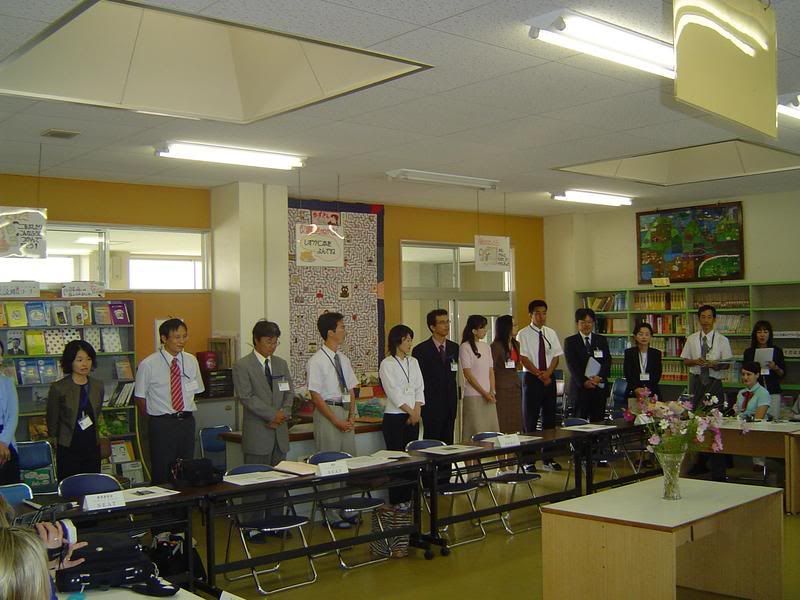
Inside the library, our make-shift camp, we had a few moments to look around. During this short time, I found a book that I absolutely had to own. Translated “Barefoot Gen” a fully illustrated book depicting the atrocities at Hiroshima during WWII from a Japanese perspective. I was both surprised and disturbed to see the sad and startling pictures used to teach children of Japan what happened some only 50 years ago.
During the meeting we could hear the star spangle banner being played on recorders through out the hallways on the other side of the doors. I made a joke to Nauoku by putting my hand on my heart and saluting, which she got and was amused at. She then translated to the speaker, the vice principle, who did most of the presentation. Hirotaka Yokote ( under Tamiko Sakai – female principal) smirked a little, but all business asked “shall we continue?” (He sported a nice suit with white and orange sneakers –making my wood-by jeans look not to shabby.)
TEACHING PRACTICE INFO (from meeting)
• Moral Education lesson taught by homeroom teacher (sometimes principal)
• Interaction with community members (trips & activities)
• GREAT IMPORTANCE physical strength; emphasis on P.E.
• Longer break between 2nd & 3rd periods (often used for students to practice sports)
• Safe transportation lecture/session (from crossing guard)
• 20 mega-language lessons to achieve a better more stable understanding of Japanese language
• 4 occasions a year were parents can come observe all the classes
• 3 occasions a year for community to come observe all the classes
• 5 members in the school advisory body
• Integrated study hours – 3rd year in the elementary school all the way to high school, example: a 4th grader may study the ocean, then have to do research and presentation on their findings
ASSEMBLY
From the briefing, we went to an assembly MC’ed fully by the students. First we watched a “Pitch Black” Performance (where they used big colorform-like pieces of artwork on a black easel with a black light to illuminate it from the dark.) Then the students sang “It’s a small world after all” in Japanese and made me feel like I was riding that boat gimmick at Disney World. Lastly, our panel introduced itself and answered a few questions from students.
OBSERVATION TIME
Coming around a corner, I saw a Japanese language course being taught, engaging in the a calligraphy lesson. I was pulled in and given a table to sit at and play the role of a fellow student along with the rest. The symbol that we learned was the symbol for “the sun.”
With a Japanese calligraphy set in front of me, I painted what looked like a box with a horizontal line through the center of it. I soon learned that timing is everything. I was shown by a third grade student that you have to do each stroke in a particular direction and at a particular time. (He was right. My second draft was so much nicer.)
It was next that I participated in a Traditional Japanese Folk “Hanna-kasa Dance.” I saw a bunch of kids dancing to music in the gymnasium with these stage props. It turns out that these red compressed looking cones are actually symbolic of ancient kasa (hats) and had bells attached to the inside to help keep the rhythm. Perfect for a photo-op, you can bet that I joined right in on the fun.
Next, I watched a compass lesson outside and that is about when I saw Laurie, an older woman (but not too old) from NJ setting up a peace circle with the 6th grade. She had them all get in the shape and was up on a high walkway ready to take the shot and her camera didn’t work! She had to have Tim take it then he said, “There no problem. We will talk about compensation later.” Laurie was so stuck on getting this shot. She has collected similar shots from what I understand across the nation –so this for her was a God-sent. She talked about it the first day at the orientation, so it was rather ironic (and almost a little funny) that things weren’t working out when it came to fruition.
10-12-06 Thursday “Lunch: You’ve Been Served”
10-12-06 Thursday “Lunch: You’ve Been Served”
A host student came and brought me to 1-1, first grade classroom one.
The first interesting observation is that the students served their classmates –YES- even the first graders. After everyone had food in front of them, a quick minimal word prayer was said indicated to me by everyone folding their hands, with a volunteer saying a few lines. After the blessing, the students began to do a curious thing, they went back to the front of the classroom and started putting the food that they had just served BACK into the serving pots.
I was confused at a moment, thinking maybe this wasn’t lunch, but rather a dress rehearsal as an exercise in serving food. Seemingly no one was eating, so I waited to see what would happen next.
Then, the first few students returned to their seats with smaller portions, reduced by reach student individually and on their own. The first grade elementary students were actually bringing back the excess portions that they felt they would not eat as not to be wasteful.
After the meal was consumed the students broke down their milk cartons for recycling, and prepared the lunch breakdown. Classmates worked together to get the cooking and serving utensils that they had utilized during lunch down the hall and into the kitchen storage facility room.
Signed a MILLION autographs and gave away all the mieshi (business cards) that I had brought with me. I wish I had brought more with me on this day as some sat back in my suitcase at the hotel. They loved my double-sided card with Japanese on one side and English on the other.
Treated like a superstar.
Osagi …Clean up time. The students went right to work. The dichotomy between American students and Japanese from my experience is not just a body of water. Japanese students took ownership and pride in their cleaning of their school, while American kids disgrace and deface the place that they learn.
I watched as the kids swept and scrubbed all the floors by hands, watered flowers, washed countertops, desks and windows and did everything that we pay custodians for in the states FOR FREE. The funny thing about it is that it is so ingrained in their culture that they all had smiles on their faces doing this work and seemed genuinely to be having fun doing it.
STUDENT WORKSHOPS
We moved into the music room next and gave a quick 5-10 minute explanation on the US educational program.
Next, students took over and gave us a taste of things in Arao Elementary School.
Our group of twenty teachers moved throughout the little workshops and participated in calligraphy, origami, how to set a Japanese meal place, how to use chopsticks, a day in the life of an Arao Elementary student and also math skills put to use.
On the way back to the hotel, we stopped at Yotsuyma Shrine on top of Yotsuyma Mountain, a very steep pitch for our bus to climb.
The area was beautiful with a full view off the mountain spanning four different prefectures. Many stone lanterns and various monuments laced the area.
Little did we know at the time, but the people at the last school called ahead and had the priest prepare a little talk for our group.
The Shitno priest informed us on how to correctly address the gods at a Shinto Shrine. He taught us that first you approach the shrine and bow twice 90 degrees. Next you clap your hands twice to awaken spirits and let them know you are there, hold your hands together and then you say your prayer. After this practice, you pull the rope and ring the bell twice.
The Shinto priest explained a lot of basic things about how most Japanese follow both Buddist and Shinto beliefs. Many Japanese homes have both Buddist and Shinto shrines. Buddism concentrates on saving the soul, while Shinto focuses on purification.
TEMPLES: Temple (Tera) are for Buddists, often a place for funeral ceremonies. Before entering, incense is burnt or often there is a smoke pit used for purification. You would find Buddist Monks at a temple.
SHRINES: Shrines (jinja) are for Shinto, often a place for weddings. Shinto believe in a doctrine that states “yaoyorozu no, kami.” In English this term means Countless amounts of gods. Yaoyorozu (countless) no (of) kami(god), 800 million gods reside in 800 objects. Priests for shrine.
It was a good time had by all. My camera stopped working due to a busy day taking its toll on a finally dead battery, so I enlisted Kip to take a couple shots for me up there.
One member of our group, Betsy, did not get on the bus and we didn’t notice her missing until we got to the bottom of the mountain. I sang Tom Jones sons in the bus mic while our guide rushed around outside, frantic looking for her up the stairs, another path down the mountain.
Betsy eventually made her way down via a car following us from the board of education.
As Betsy entered, I said in the mic in a deep and ominous voice, “Betsy – this is God. Stay with your group next time Betsy.”
10-13-06 Friday “Junior High”
FRIDAY, Oct 13, 2006 “Junior High”
TOP SECRET MISSION PROFILE:
Arao City Daisan Junior High School
Hiroshi Koba, Principal
Keisuke Mitsugi, Vice Principal
700 Honide, Arao-shi, Kumamoto 864-0012
TEL: 0968-66-0462 FAX: 0968-66-0977
(This message will self destruct in 5 minutes.)
Arao Third Junior High School’s motto is “Full of Green, Flowers and Energy” located north east of Arao city, the school is right next to Omuta City in the Fukuoka prefecture. Coincidentally enough, it is only two blocks or so behind our hotel – the illustrious pink and green -Hotel Verde.
At one time this school had over a thousand students, but now there are only 232 students. At one time Arao city was a big coal mining city, but about ten years ago the coal plant closed, due to a diminishing supply of fossil fuel. In 1955 there were 1,500 students at Arao Third.
When you mine, you take coal off the surface then go lower and lower. It eventually got to the point where they would have to go so low that operating the mine no longer became cost effective. Many people moved away and have since added to the declining birthrate of this once vibrant town. Many of The one who remained Therefore, Arao is now living primarily off of its agricultural resource as a source of citizen income, the pear.
I haven’t mentioned this yet, but Arao’s logo has a pear instead of an “O.” The pears are round and a peach color and taste like a juicy mild apple. They are also the size of a large grapefruit or cantaloupe.
…This just in… Coal & Pears as Arao income will be covered more in depth in tomorrow’s broadcast. Stay tuned.
The mayor mentioned a few days ago that some of the middle schools are endangered of being combined/closed. The declining birthrate will force them to soon make some decisions about the current educational layout of facilities across the town.
Today the principal met us in the library of Arao Third JHS along with all the staff. We exchanged introductions and finally, Deborah a principle of a middle school near Boston, MA got her introduction somewhat right, not fumbling and leaving out words as she has done in the past. Our group applauded as she blushed.
Next I made my speech, as “Speaker of the Day” was bestowed upon me on this fine and sunny Friday. Here it is:
First off, we would like to thank you from the bottom of our hearts for welcoming us into your honorable and prestigious school. Whether you know it or not, you are a big part in creating an experience that will last with us for the rest of our lives. We have already experienced so many wonderfully different things in Arao.
1) In America, my pant size is a 36… In Arao it is a 97.
2) In America, when we eat a pear it looks like this. (here I motioned picking up a small piece of fruit and biting it easily.)… In Arao when we eat a pear, it looks like this. (I then motioned picking up a huge and heavy beach ball sized pear, rubbed it off on my shirt and took an enormous bite.
3) And, in America we have a saying, “I am so hungry that I could eat a horse.” … In Arao, some of us last night did just that.”
(Though we haven’t had it yet, we plan on eating Basashi tonight, which is like sushi – but RAW HORSE MEAT! Kumamoto is one of the very few places in the worlds where the people eat horse. I will certainly report my findings on this in a later journal.)
We represent many of the states from all over The United States and you should take pride in hearing that your Shoudai pottery is among the best pottery in the world.
Aside from all our differences, we have a lot in common too. We all are here to do one thing –and that is to educated the people who hold the future in their hands; the children.
We thank you again for helping us to understand how to teach them in your land, our land and around the world.
After I read this speech, I gave the principle a gift bag and he gave us all a special chop stick and chop stick holder coincidentally made of Shoudai pottery.
We had a quick Q & A session and learned that this middle school practices a no-bell system to help get the students into a self reliant mindset.
Things seem a bit more rigid from the pedagogy that principal portrayed. He talked about the importance of class control and self discipline quite frequently. One goal of the school he said, “is to boost reading, therefore we have a silent reading time each morning for 20 minutes.” Another goal is to teach discipline. One example of this that he cited is a recent school-wide mountain climbing activity.
EVERYBODY OSAGI!!!!
All students participate in “Osagi” cleaning duties, quietly without talking. The kids worked diligently on cleaning the floors, as they did the in all the other schools. Others watered plants, washed windows and cleaned sinks. The principal stays active in all areas.
A funny moment was when I asked a tiny teacher for a picture wth her during class. She agreed and I gave her my Meishi (business card) which has a English on one side and Kanji Japanese on the other. It also has a goofy picture of me, designed to make kids laugh. She was thrilled to get it and went to pass it out. I then gave all the kids in the class my card and they jumped for joy.
Later in the day, kids followed me around chanting: “Me-ei-shi! Me-ei-shi!” as they would at a baseball game or wrestling show. I was out of cards so I gave them all altoids and let me explain something to you. Super strong mints are not a taste that the Japanese are accustomed to and some liked it, others faced shrunk up like green tea leaves in water.
Here in the final Q & A session, we learned that Kumamoto requires all new teachers after three years of service to teach at a rural school. After 14 years, all teachers have to move to a new area. Also, I learned that teachers seem to get like 24,000 a year – though this figure may be different as there was some discussion on whether the translation was correct or not –AND the teachers don’t get anything for extracurricular activities more than 10 bucks. (The scary part about that is many don’t get home until 7-8pm!)
For being a very “rigid school,” or so I thought, the principle was awesome. At the end of the day he hung out with is and laughed and told jokes – a real down to earth kind of guy. A funny thing was that the day before we had to sit through an entire hour and a half direct instruction assembly on why you shouldn’t smoke. This principle invited Tom, Virginia and myself into his office to light up a Marlboro.
Curfew hit us and we rushed to our us to see our friend “The Prime Minister” once again, dubbed as so because he shared the same family name as the current Prime Minister of Japan. (I mean our bus driver.)
The teachers of the Elementary school all lined up and waved goodbye as we drove away. This was a regular practice and in return we would wave and bow from the bus for as long as we were in sight of them, driving away, a business custom taught to us by our group coordinator Naoko Oguruma. (Naoko’s regular profession is interpreting for businesses who train American businessmen in Japan.)
14.10.06
10-13-06 Friday Night “I am so hungry I could eat a horse!”
10-13-06 FRIDAY NIGHT “I am so hungry I could eat a horse!”
Well, after a week with out Internet, I know now that I am not totally an addict. Though I was jones’ing at first to get a web fix, I made a sacrifice, and it didn’t really hurt all that much.
A number of us were planning on going to The Internet café, which was back near Omuta, the first hotel we stayed in after our flight to Kumamoto. At first, interest for this trip included just enough for one full cab load, but soon there was a 5th man out and a cab issue.
I had a TON of entries to post; everything you see before this entry, totaling somewhere in the area of 35 pages single-spaced. The problem was that the diver would only let four in his cab (with one in the front) –not the five that we had.
We were totally prepared to get two cabs, but I sucked it up and decided not to go. SO… that proves it. I am not addicted.
I rather did some laundry with my man Tom, a cool music teacher from Minnesota, so I would have less dirty underwear when we hit Tokyo a few days from now.
Next, we went to You MeTown, which essentially is a Japanese super Walmart. It is weird though, because each department is owned by a separate business, therefore you have to buy the merchandise nearest the cash register where you find it.
Tom (a music teacher from Michigan) and I got some tempura there. I got the chicken, he got king prawn. Meeting back up with Virginia, we walked over to the Japanese McDonalds set up (like they have in some Walmart’s back home.) The funky Latina was dining on a Big Mac, Miami style in Japan.
Again, even this entire megalithic store had no clothing clad in kanji text. Anything that could be worn had been Americanized and 95% was in English to boot.
After returning to the hotel room, I had to make a choice; meet up with the principal of the middle school we visited today at a place called “For People Who Loves To Eat,” or wait for the group that went to the internet café so we could eat some “local cuisine.” In hindsight I made the right decision.
Kate, Meg, Jenny, Kip, Andrew and I headed out to a smaller restaurant whose name we have no idea. It was a nice little place with about 6 booths or so. We ended up doing what we typically do and that was to order a bunch of food and just eat off of everyone’s plates. (Most of it being served family style anyhow, this was the best way to try new stuff.) The tables had a Korean BBQ grill at each and both of our tables took advantage of it. Frying up some excellent shitake mushrooms and chicken strips, we couldn’t wait for what was next. (Or at least some of us couldn’t wait. Others were perfectly content with waiting.) Yes. This was the night we were to eat Basashi! (Not just horse meat folks… RAW HORSE MEAT.)
It actually wasn’t bad and was very much like the sushi or raw beef we had eaten when dipped in a little soy sauce.
After eating the horse, I ducked out a minute to see if the principle was at “People Who Loves To Eat” with Tom and Virginia. Turns out that though he no showed, but I rather think his saying he would meet them was lost in translation as he didn’t speak very much of any English.
As we were leaving, Meg (a music teacher and opera singer) and I hooked up with two other ladies from JFMF who wanted to do karaoke. So we stopped in a karaoke bar down the street to check it out.
It was much more lame than the ones I have seen in the states. Something like a $20 cover charge and there was only one guy and girl in the joint. It looked like a walk in closet with a flat screen television on the wall. Anyhow. The four of us opted not to sing yet, but laid out a plan for SUNDAY! The women went bowling, I went back to the room for some shut eye and decided that since I have gone almost a week without a treadmill, I should go rock it old school and run through Arao.
Feeling like Godzilla in tennis shoes, I ran in the dark through a tiny suburban area behind our hotel. Using the heinous Ferris wheel as my breadcrumbs, I was safe to run anywhere and find my way back home through the rows and rows paper houses.
When I got back, I felt like I had finally accomplished something so I grabbed a shower and listened to the Japanese version of The syndicated Delilah Show. This channel had no DJ but featured mostly soft rock & love songs from America –some of it original artists and some of it Japanese covers. (Killing Me Softly sounded more like “Kirring Me Sofry” but who cares –right?)
Made a sweet $20 international call home.
Sleep.
10-14-06 Saturday “The Host With The Most”
10-14-06 SATURDAY “The Host With The Most”
Packing was crazy. The deal is we had to get together one small bag and leave the rest, because it is unheard of to bring so much luggage (3 weeks load) into someone’s house unless you are like moving in.
For one, I have no room in any of my bags, due to sample Japanese text books given to us by the schools that we had visited and all the souvenirs (junk) that I have been collecting of late. The other problem is we had to carry our overnight bag with us on the bus to the first activity. With all the text books in my carry on, I could not see this working with out breaking a shoulder.
Improvisation. I looked around the room for an answer. I thought about wiping a pillow case overnight as it worked out nicely for my laundry. I ended up having to put the clothing that I was going to wear at my host family’s house in a video camera bag. Only having less than a half of a loaf of bread’s worth of space, I had to pack light.
This is probably the lightest I have ever ever packed going anywhere. One T-shirt, one pair of socks, a pair of pants and a toothbrush. Because we were told to expect the hosts living conditions to be something REALLY small and far less footage than what we are use to living in back home, my lack of bag space was good for Japanese tradition by this point. As most Japanese houses are tiny, our guide said we would look like pack-rat monsters bringing so much into a place their home. It would simply not make sense.
Next we made our way via bus to the Traditional Japanese Tea Ceremony which JFMF and The Ariake International Cultural Society hosted at the Shoudai kougeikan Craft Museum in Arao. This great little lesson benefited us as educators from America, as well as the host family participants –in that these days many modern busy Japanese families never get a chance to partake in this peaceful ancient ritual.
In Japan, drinking tea matured over time into a highly developed culture called “The Way Of Tea.” This “Way” is related to various Japanese arts and philosophical principles expressing harmony, respect, purity and tranquility.
Our ritual was timely praising the season of autumn in front of a Shinto altar that had a Japanese flower arrangement and a small flute. The flute was included in this ceremony for three reasons by our tea host. One was to give a feeling of music to our ceremony to get a feel of autumn, the season being honored. Another reason the flute was included was to provide another element to give thanks to, as Shinto’s believes there is a god in every object.
In order to seat us all at first by means of Japanese kneeling-style in on the tatami bamboo mats (often used as carpeting in most homes in Japan and many Japanese restaurants,) legs were cramped and many of our older group members had an uncomfortable experience. While we were allowed to sit with our legs folded in what we used to call “Indian style” in kindergarten, our knees hovered over our neighbors lap.
This only lasted a short period of time during the welcome, because the group was then divided into two. One group engaged in the formal traditional ceremony where we were served by staff dressed as tea girls in full komodo gear.
Next, a tea girl sauntered up to each one of us and kneel four feet or so away. In a red flowery komoto, mine bowed over, entirely, making her face practically touch the floor in front of me.
Second part – serving your host family. I made a big boo boo. In the next room, we were given some sugar candies that represented various different plant life across Japan. These are to be served before the tea. Not thinking while I was watching some of the board of education drinking tea so we could see how to serve them by the tea girl instructors, I watched them take a bite. They started eating the candy, so then I ate a candy. The difference was, I got yelled at!
Despite the fact that this was an informal instruction, I didn’t realize that I was to be serving my host family mom first, and wait to have one myself later. So I gave Terumi some candy and picked up one for myself …and popped it.
Naoko Oguruma, our Group Coordinator, saw me eat and was appalled.
“You are here to serve your host! Not yourself!”
I became the ignorant American in her eyes that I knew I already was, but was actively trying to hide. I knew this would eventually happen so I laughed it off. Oh well.
I whipped up some potent green tea and Naoko laughed because it had almost NO FROTH. When Naoko turned around, one of the tea girls came over and whipped it up, giving it a full head of foam. I finally presented the cup to Terrumi, my host family mom. She took the tea, spun the cup around as we were taught in the other room and drank it. (You are supposed to spin the cup and drink from the dullest side of the pottery and place the most decorated side out to show that you are humble.)
She even pretended to like it too!
After a few photo-ops at the tea table, we were ready for lunch. As I was ready to sit down to eat with Terumi, her husband Syouji (a public official in Arao) and his son Satoshi (a 20 year-old student) came along, grabbed up our box lunches and whisked us up like green tea. I was off to The Kumamoto Castle Festival.
My family was very down to Earth. The son, a big fan of basketball, was funny. He really wanted to sit in the front, but was humble and asked me if I would take it. I told him no, but then later had second thoughts. The ride there was very scenic, but let me tell you, Syouji drives like crazy! I started to get car sick, but swallowed it back and bit my lip. Part of what made me dizzy I believe cold be that they drive on the opposite side of the road in Japan and with all the windy roads, it looked like we were going to get hit upon every curve throughout the rice-field laden journey.
An interesting additional point though about the trip was hearing the “navigator” beep and chirp like R2D2. There is a computer in most decent Japanese cars in the dashboard that makes the inside look space age. When we got to our destination it played a congratulatory Da-da-da dah- da-da… “Charge!” jingle.
We ate our box lunches picnic-style at the park just outside of the large piece of Edo architecture, marched across a bridge and paid the 600 yen fare. The castle was enormous! Inside, a number of artifacts filled it out into a nice little museum. A few displays that stand out were a large gothic looking dolphin sculpture used on the roof to keep away evil spirits. And yet another interesting display was a large imperial boat used by a former emperor, all decked out like it had seen an ancient Edo version of “Pimp My Ride.”
Much like the Statue of Liberty in NYC, we climbed up the dozens and dozens ‘o flights of stairs until we had made it to the top.
Once there, the castle top was much like the Statue of liberty. Aside from the wonderful view of Kumamoto City (about an hour from Arao) there wasn’t anything else much to do or see once we hit the top, so we left.
The Matsutaka family then walked toward a second castle. At the entrance, we were handed hard hat helmets, construction-worker style, and journeyed inside. In the second castle, renovation was being had to replace of the entire support system throughout the castle. There were tools and machinery much throughout the display and it was actually quite interesting to see the bare skeleton that held up such a large structure.
After the castle, we went down in the courtyard and watched a splendid ancient Edo martial arts display. Some highlights included women’s bow staffing, kendo, kitana sword action, archery and judo.
There was also a hand-held canon presentation. These looked really big, but the noise they made was even bigger. Watching these exhibitions was something else, having a stone wall in the backdrop with the Samarian Kumamoto Castle poking out of the skyline.
After we looked at a few fair-like stands, we went to engage in kaemoto (shopping). I must say, my host family went way out of their way for me, above and beyond the line of duty.
In the car, I gave my hosts each an altoid candy, as they said they have never seen the type of candy I had. However, in Japan there is no real bold taste like the little mints and they quickly wrinkled their noises and laughed at the potency of the little chalky white tablet.
In unison, they all spit into a tissue and laughed, “Argghh! NEW YOURK!”
Stop at martial arts store that had HUNDREDS of kendo sticks in bins at it entrance. The family asked if I wanted to get one. Because they speak almost no English, the son got out and interesting hand held calculator translator. I explained to him that I would love a kendo stick, however, that George Bush wouldn’t allow me to shop here because of what I would have to take on the plane with me upon my return.
They laughed at this too.
One little area that we stopped in looked like a mall, but outside. Down a long alley, we shopped for the items I had expressed to my family that I had wanted. A Noda whistle, Barefoot Gen book (a book on WW2 that was found in the Elementary school visit), Kanji script T- shirts and/or hats. Nothing was to be found, and I have come to the conclusion that Japan does not like clothing without American text because American text is IN STYLE.
Out of the ten shops or so that we peaked in, I ended up with wrestling mag in Japanese.
On the way home, hospitality continues and so does the English/American theme in Japan. The host family played the Beatles most of the way home.
By the time we returned, I had the wrong shoes. I went to put on some “Keeping it real” brand flip flops that I had purchased from the 100 yen store in Tokyo. My family laughed and gave me some actual slippers.
The family, again, went all out and tried to give me a full experience of Japan, Arao style. Dinner was a side of sushi and ODEN. Oden is like pot roast with a large pot under a flame filled with fish, tofu, carrots, some kind of vegetable, some rice sticky thing. Everything was very good.
They really wanted me to drink beer and could not understand why I would not. (I almost NEVER drink.) I told them with hand gestures that it makes me sleepy. They laughed and served me water.
With his calculator out, I asked Satoshi if this was a normal dinner for them, or if they had cooked extra for me. I learned that the Oden is something they often have and they love that dish, but the sushi was something they whipped up for me. I bowed and ate some and told them it was “yummy.”
My family was funny and kept offering me a fork, as does much of Japan. However, I wanted the full experience so I roughed it through. I am actually getting quite good at using them now.
Later that night, they offered me a Japanese bath. The way this works is they draw up a super hot bath and shower off, then sit in it for a few minutes, which literally is all your body can take. It was funny, because once again, Satoshi wanted to break the tradition of “the guest goes first and asked if he could go. I totally had no care in the world about this, but his parents said no way. The bath was real nice, but OWWWW! (how can I say this nicely?) The sitting almost emasculated me.
Internet for first time in week! (No treadmill either incidentally.) I was up until 2:30 working on my lap top.
10-15-06 Sunday “The Matsutaka T Shirt company”
10-15-06 SUNDAY “The Matsutaka T Shirt company”
I got up to do some more Internet work. Getting this journal out there was difficult, so I had my sister do half the work and got twice done in the same amount of time. AOL IM works fine in Japan.
After a while, the parents made me put on their daughter’s kendo uniform to take pictures. It was funny because the superstar American status kicked in as I then had to pose with two different neighbors.
I didn’t realize last night that outside and behind my host house there was a sizable farm that I couldn’t see at night. It wasn’t their farm, but it made for quite a nice view.
Next, we drove a few minutes away down to the Children Festival at a Shinto temple. The temple had a very fair like feel, as there were many vendors and booths to win prizes at. I got a real timely snow cone, with it being about 70 degress out in October.
I noticed that our dialogue was becoming overly simplified. My speech changed to a more simplified deal when I realized that they understood practically nothing but a few words in English. I ended up using just key words that are “easy.”
At the children’s fair, many families dressed up there kids in little komos or yukatas (cotton robes).
There was also a pretty neat parade” of sorts as a number of color-clad Japanese kings men brought a prince to the Shinto shrine to be purified. This reenactment came with full song and dance and the prince rode in style on horseback through the crowd.
Lunchtime. My family asked me what I wanted and I told them I didn’t care, but would prefer something inexpensive that they enjoy that is specific to Japanese culture. We went to go have Japanese pizza.
Okonomiyaki is not really pizza at all. In fact, there is no dough, no tomato sauce and no cheese involved, and they cook it in front of you on a grill in the face of your table. Okonomiyaki is really more like a mixture between a pancake and a pizza. “Okonomi” means “as you like” referring to how the ingredients are put together.
Hibachi is an American term and we understand it to mean a restaurant where they cook your food in front of you. In Japan, it just means grill. While they do cook the Okonomiyaki at your table at “The Kousendago,” it is not an Americanized Hibachi deal, complete with a performance for entertainment by the cook.
Okonomiyaki is an odd but tasty concoction of meat, noodles, cabbage and some sauces to glue it all together. The mixture is stirred and applied either in a large rectangular shape or circular by shaping it out of the bowl and onto the grilling surface.
Here is the recipe:
DOUGH
300 g flour
210 ml water
2 eggs
Cabbage
DOUGH EXTRAS
Possible ingredients to put into/onto Okonomiyaki
Katsuobushi*: Dried, shaved benito (katsuo)
Aonori*: Green, dried seaweed.
Leek or green onion
Beef: thinly sliced or ground
Pork: thinly sliced or ground
Chicken: breast filets
Octopus*
Squid*
Prawn
Tuna
Mushrooms
and much more…
DIPPING SAUCES
Brown okonomiyaki sauce spicey or mild*
Mayonnaise
* May not be available in Western supermarkets; but you should be able to find it in Japanese grocery stores that exist in most large European and American cities.
PREPARATION:
1) Cut four large, green cabbage leaves without the hard, white core in thin strings (ca. 4 mm).
2) Mix the water, flour, eggs and the cabbage strings together.
3) You may now add more ingredients to the dough: e.g. seafood, cut in little pieces, ground meat, cut mushrooms, etc.
4) Fry the dough like a pancake in a small frying pan.
5) Before turning the okonomiyaki over, and while the dough is still quite soft, you may put other ingredients on top of the dough.
6) Turn the okonomiyaki.
7) When fried well, serve the okonomiyaki with katsuobushi, aonori, mayonnaise and okonomiyaki sauce.
It is notable mention that depending on the region of Japan, okonomiyaki is prepared in various different styles and house secrets are part of the charm of eating at this “Japanese Style Pizza Parlor.” In Hiroshima, which is especially well known for its okonomiyaki, it is served with or on top of Yakisoba fried noodles. In Arao, a number of herbs and spices pepper a bed of Okonomiyaki sauce baked on the top.
After eating the entire thing, again, I achieved American superstar status and posed for some pictures with random customers (fans). In Arao, many people very seldom see people who are not of Japanese descent. And because American movies and/or television is very popular with the Japanese, when they see somebody from the states, they think he/she IS really a somebody.
SHIRTS
After a great meal that couldn’t be beat, we went out shopping again in Arao this time. Because we had no success finding any Japanese script on T-shirts, my host family decided to make some with special computer iron-on transfer paper. We stopped and got t-shirts and went right to work on the designs. I worked on the computer with the son and we made two shirts successfully related to my trip. On one shirt “Basashi” was printed in Japanese over a stallion’s head. On the other “Gyjin” (a word that translates into American Idiot over a yellow star.
Before I left, my host family gave me another Japanese hand towel (as they did the night before) and also a little hand bag pouch to keep things in. Sateshi gave me two DVDs of Japanese music that he burned off of his computer.
When we got back to the hotel, I said goodbye to my family and exchanged information.
MAKING WEIGHT
With all the stuff I had purchased coupled with all the gifts I had been given, I really had to weigh my bags. Weight restrictions on the plane could have cost me up to $300 for an extra bag, or losing all my stuff. From Arao back to Tokyo, we were allowed to have 30kg as a check in on the plane and 15 as a carry on.
I went down into the Verde communal bath locker room and found a small stepping scale. I was told it is easiest to weigh yourself and then subtract your weight a second time holding the luggage. Someone told me that the conversion to pounds was times 2.2. This didn’t make sense to me, because at 75 – that would put my own weight at about 5 pounds or so less than I should have weighed. It was true, I lost even more weight.
I believe that the weight lose was from eating so much raw fish and not a whole lot of bready things. This too must be attributed to why the Japanese does not have an obesity problem (save for the sumo.)
After I did some shifting, the two bags were up to par.
I bought two yakatore at Mammy’s grill by the laundry mat. Yak ore is meat on a skewer. They had such a strange selection. Beef, chicken and pork were the regular selections, but they also offered chicken skin, gizzards and Japanese pig’s feet on a stick.
I met up with Kaye’s host family who were looking for her at the front of the hotel and called Nayoku from the house phone. She spoke with them, and I watched the family set up camp in the lobby to wait as I went up to my room.
I put on some gym clothes and went for a run . I ran to the middle school that we had visited a few days before and skipped any real kind of dinner. When I returned I saw Kaye’s family still waiting in lobby and also saw Kaye in hallway behind a wall where neither could see each other. They would have missed each other if I didn’t say anything.
I went up into my room, ready for bed then a got a call from front desk. My family returned and brought me another shirt with my name on it in kanji. They were so cute.
I fell asleep, but then got awoken by Kaye’s host family on a house phone and had to quickly dress. The gave me some octopus and a Japanese kanji towel for helping me connect them back up with Kaye for the evening.
I feel really bad, but accidentally left the octopus in the fridge the next day after check out.
10-16-06 Monday “PTA, Coal, Pears and Karaoke”
10-16-06 MONDAY “PTA, Coal, Pears and Karaoke”
In the morning, we brought our luggage down to the lobby to be weighed. My luggage passed. Then we had a little discussion on what we would do for our presentation to the other groups on Wednesday afternoon in the lobby. One member acted like a control freak and took over the discussion and left a bunch of us out. I tried to interject some kind of participation on my behalf, as I really wanted to take part, but the control freak was very stubborn.
I cursed him out and told him I didn’t appreciate him treating us like students.
Many agreed he was being ridiculous, so we just gave up. I boycotted the planning session and let control freak do it himself. The JFMF Handbook specifically addressed this, but he broke the rule anyhow. I lost a lot of respect for him, as I thought he was doing this early on, and then double guessed the situation and figured it was a problem I had in understanding him –and put the blame on me. But I was wrong. Needless to say, I didn’t talk with him for the rest of the trip. I don’t know if it is professional to write about this here, but there is always one in the group; the only real downer of the trip. Good luck to him and his alcoholism later in life. E.A.D.
(Damn, that was cold.)
After check out, we took a bus to the Arao Coal Miners Museum. There we had a long Q & A session with the PTA members of a few of the schools that we had visited.
· There are no mid term progress reports
· Report cards are sent to the parents three times a year (one for each of the three marking periods
· Most students are home by 5:PM or so except the college prep students
· College Prep students are home by usually 10:30 PM every night
· College Prep students have homework and usually study until 1:AM in the morning or more
· Most free time for the families to spend time with each other occurs on Sundays
· Schools were on a 6 day schedule, but recently moved down to 5 about 10 years ago
· American/Western educational systems are looked up to and The Japanese, though they have better students as a whole wish to institute more practices like they see from the west
· April to March school year with 1 week or so between semesters for break
· The board agrees that they would like fathers to play a more active role, though it is difficult because how many hours businesses force them to work
· It is very difficult for fathers to leave work so they are not very active in raising the students, let alone interaction with the schools
Next we spoke with the Board Of Education and the Arao Superintendent. We learned some more important things about Japanese schools:
· Teacher evaluations are no longer public, but are now more standard. In the past, there was a different practice at each school. Now it is more uniform
· Goal setting is done yearly with the principal, based on the teacher’s own set of goals
· The Board is trying to institute and promote a more self reliant attitude in all children
· The Board also wishes to promote better self discipline
· The Board’s goal is to instill a stable economic ability & physical strength within each student and help them to be life long learners
The next activity in this busy day was to leave the Arao Coal Museum and head on over to an actual Coal Mine. At the mine, we were welcomed by two former employees of the mine.
The employees took us on a tour down the shaft and around the facilities. The place really looked like a ghost town from Scooby Doo. Again, Arao once being a major coal mining town, but it has since lost a great deal of its population, due to the closing of the mine back some 11 years ago. Everything was left seemingly untouched.
The next little trip was very nearby to an Arao Pear Farm. The way that a pear farm works is that there are bars along the tops of the trees to help support the heavy weight of the enormous fruit so that they can grow larger, staying on the stem. The funny thing about this farm though to e was how low the bars were. I had to duck everywhere, much like I had to do at a number of doorways, in order to coexist among the fruit.
The Niitaka Pear, also known as the Jumbo Pear is Arao’s famous agricultural product. They can grow as big as a baby’s head and Arao’s production rate is the 2nd largest in Japan. Pure white flowers bloom on the trees in spring and golden fruits are plump in autumn. It is crunchy and sweet with a distinctive flavour. There are many varieties including the juicy Kousui and lighter flavoured Housui.
Arao City’s official flower therefore is the five petaled, pure-white, pretty flower of the pear tree. Because of a warm fall, we were fortunate enough to see one on a branch. The farmers said that the branch had been tricked into making a flower by mother nature.
During spring, these buds bloom in masses, making Arao beautifully picturesque. Volunteers started planting the trees around 1907, and they have now developed into impressive orchards. Visitors are attracted to Arao to try the famously delicious Arao pear which grows from the same trees later in the year.
The best season for individual kinds of pears in Arao run like this: – Kousui : mid to end of August, – Housui : end of August to mid September, and – Niitaka : end of September to end of October.
Local products made from the pear include wine, pie, jam, and a barbeque meat sauce.
The last little trip was to the ryokan, where we would split rooms on our last night in Arao. A ryokan is a traditional style hotel with paper walls, sliding doors and tatami mats. You had to actually take your shoes off in order to be I your own room –the whole 9 yards. The name of the ryogen was The Shogen Sanso.
The way ryogens work is you typically have to book at least two people and the main attraction is actually the food, not the room accommodations. Our room was very cool, however and it was different to sleep on floor futons that are pulled out by room service while you are eating.
We had a delicious 12-course Japanese style meal. I was into almost all of it, but the sea urchin and the row of curiously strong fish eggs. They also had a slab of some really good beef, the first real beef I had had, except for some yakatore, the whole trip.
After dinner, I was in my element. Our room hosted a karaoke machine and stage, complete with a costume closet. The International Karaoke Champion, yours truly, defended my title successfully against about 15 challengers with Elvis, Jerry Lee Lewis, Frank Sinatra and The Village People all at my side.
One teacher got really drunk and was in bed probably by 7:30PM. It was funny because a bunch of the others took his camera and took a million pictures on it, complete with rude gestures and shots of toilets.
26.10.06
10-17-06 TUESDAY “Better Than Bubble-Wrap”
10-17-06 TUESDAY “Better Than Bubble-Wrap”
Before I checked out of the ryogen with an hour flight to return us to the New Otani in Tokyo, we had some breakfast, again food being the main feature of this type of establishment’s focus. It was pretty good, as all the trip’s food was, featuring a mini crock pot of rice with bacon in it over an open flame and some kind fish (raw of course) still on the bone. Eggs were also served, however, they were not cooked!
From talking to a few of the people at the table, I learned that a number of their host families engaged in eating raw eggs. Many would just crack the egg open into a salad or over some rice and slurp it up all yellow-yokey; uncooked just like the chicken made it.
Laurie, who I believe is a vegetarian for the most part, on this particular morning took the egg and boiled it in a crock-pot.
We jumped back on the plane and I read a bit and played some with my some 2,000 pictures. An uneventful trip, aside from seeing Mount Fuji from the window, provided us with a very smooth landing –perhaps may I say, the smoothest one ever. It felt like we didn’t even touch ground and we were down.
Back at the New Otani in Tokyo, I picked up my bag of junk which I had left before leaving for Arao a week ago. Next, I snuck in a run before some of us wanted to go out to Asakusa for some last minute shopping by the Asakusa shrine with Deborah and Mary Ann.
I finally found a few shirts with Japanese script, however, none of them were my size. I did pick up some alcohol though for the hommies back at home who would love to try some saki. (I am so thoughtful, as I am not much of a drinker myself.) Being allowed to have a second check bag to get home, as we were only allowed to have one bag on the way here, I was seriously running out of space.
Later that night, we traveled back to Tokyo’s answer to Times Square, Shibuya Station, for one last romp through the world’s busiest intersection. On the train ride over, we hooked up with two American G.I’s who were looking for something fun to do, before being sent off to Korea, as Korea has acted up again in the U.N. in it’s hopes to be a nuclear world-wide force. I introduced the G.I’s to Hachiko and then we stopped into Harley Davidson – Shibuya so that one of the teachers could pick up a $70 t-shirt.
After we peaked into a number of little shops, we called it a night with a last peak at TOWER RECORDS – a CD store that has eight separate floors of music categorized by genre.
Back at the hotel, my strategy for getting three big bottles and four little bottles smuggled back into the states was interesting. I put the four little ones into shoes, wrapped one in a shirt and the other two in bottles. There is some restriction I think on bringing too much alcohol in particularly back into the states, but my plan did work, and with no broken bottles. Many of us stressed out about what to do to get all our stuff home with the different weight restrictions that had been placed against us.
I actually ended up using the majority of my clothing to wrap all my goodies in to save space, rather than newspaper. And let me tell you, underwear is better than bubble-wrap.
10-18 Wednesday “Group Presentations and Uno Kenny’s Bar”
10-18 Wednesday “Group Presentations and Uno Kenny’s Bar”
Not a whole lot to say. The group presentations lasted a good part of the day.
There were 10 different groups of 20 educators coming from various points across the USA. We all had many “once in a lifetime” experiences to share with each other. Whether it be by PowerPoint, poem, song or video, we each displayed our journeys in our own individual ways… (sometimes.)
An ongoing “though-to-be-clever” gag was to narrate the presentation in Ryoken theater style. Just like the art form we saw early on in our Tokyo stay, the groups would have members execute narrative in a ryoken-esque slow, exaggerated, deliberate wavering voice. This would have been very funny and was –the first 3 or 4 times that a group chose to do it. However, by the about the seventh time, I had had just about enough of that joke and was wishing that I had kept a motion sickness bag from the air-bus.
Things that we seemingly all observed included taller people hitting their heads on doorways and the resonating way that kids and Japanese teachers alike greeted people “ohiyo gozi-maaaaaaaaaaaaaaaaasss!” holding out the last syllable as long as possible.
One group visited the International Ramen Noodle Factory. Another group went to Disney Tokyo. Another one was in an area that had an earthquake while they were there. For the most part, aside from societal features, all the groups had the same itinerary as u;, to visit each level of schools, a number of cultural visits within the host city, a stay with a local family, and a night at a traditional ryokan hotel.
For our group presentation, I let the dominators do their thing. I sound bitter, but not totally. I did volunteer and passed out diced jumbo Niitaka Pears from Arao. I just think it would have been nice to be included when you wanted to help. Our presentation was a little flat on the entertainment side, which I know a few of us could have spiced up on –but whatever. I will being a TON of presentations my way when I get home anyhow. (And Kate did do a super job with her video put to music.)
After the group meetings, I met up with Tom, Gina, Virginia and Dave with The Indiana Jones hat at a place called aptly “Kenny’s Bar.” Kenny’s bar was a quant little typical Japanese establishment, seating about 10-15 people tops comfortably. There was a tiny piano in the corner that I understand the bartender would play from time to time. Being not much of a drinker, I ordered a water and got a seltzer water. Yuk.
Everyone has strange things that they do. Mine, from time to time, is I get together with the boys and play cards. No, not poker… UNO.
Yeah. We have a championship wrestling title that the winner of each hand gets to wear and then puts an interview on the losers WWF style. We call it Hardcore UNO.
Why do I mention this? Before I left the states, just as I did when I went to Jamaica a few years ago, I won the title and swore to defend it at least once while in Japan so that we could keep up the championships international status.
I played one game against Gina – AND KICKED HER @-$-$!
What a perfect way to spend the last night in Tokyo. I went to bed and snuggled up with my International Hardcore Championship title and went to sleep listening to the smooth sounds of Japanese Delilah.
29.10.06
10-19-06 Thursday “Destination USA: The Final Frontier”
10-19-06 Thursday “Destination USA: The Final Frontier”
We had an hour and a half drive to the airport ahead of us, then a 12 hour flight to Chicago. At 7:20AM, we put our luggage outside the room with green ribbons on them to mark were they were going then left for breakfast, individually, but still paid for by JFMF, as everything has been this whole trip. (Many dinners we were on our own, though we were given 260 Yen upon entering Tokyo the first night to buy our dinners and try out different restaurants throughout the trip. I went through that though in the first few days.)
This morning for breakfast, as I had done a few days before, I turned my nose up to all the usual breakfast meats that I savored and grabbed a bowl of cereal. I remember specifically saying at the beginning of the trip that I couldn’t understand how anyone would choose cereal over eggs, bacon and sausage, but because my diet had been lacking in dairy (which I love) I decided to “rock the corn flakes.” (Denying me of dairy is like keeping the mouse away from cheese.)
There I sat with a cool teacher from DC. I told him I really wished I had bought a Kanchu T-shirt that I had heard about from another teacher from Shibuya, but I hadn’t seen it. He said there is still time and if anyone could make it to Shibuya and back in an hour, “No-Pants Man” can.
He was right.
I finished my frosted flakes, slurped the milk loudly (you do this to compliment your host –but usually with soup) and headed out to the Ginza Line.
I walked right into the subway, bought a ticket with out looking and found myself sitting on a very crowded train. I didn’t think once. I looked up at the yellow sign, adjusted my spot on where to hop on the train and did even think twice. It was instinctual!
A few minutes into the trip I found myself wondering, “How was I able to do that without any problem whatsoever?” It seemed before there was always a bit of a hassle or some double guessing before jumping on a line. -But not this time. …Not at all.
It was an odd thought. I was on my way to a location in a strange and distant world and in their language I could only really say, “Hello”, “Good bye” and “Where is the bathroom?”
Shibuya Station in the morning had just as much volume, if not worse than it was in the evening. The only difference was the crowd shifted in locations. The hallways in the subway were WAY more full and the trains themselves were wall-to-wall people. However, there were less people in the shopping areas, because of a tidbit of info that I was about to learn.
I walked around and got some really cool shots of the designated smoking area, Hachiko in the morning light and businessmen off to work. It was 8:30 in the morning, I had to be back in my hotel by 9:00… But the stores didn’t open until 10:AM.
It was okay though because I shot some really cool pictures of a rent-a-room karaoke joint and a couple of Harajuku girls near Condomania.
As directed by Jen & Kip who saw my treasure the night before, I went looking for the T-shirt store where my Kanchu T-shirt was being besieged behind lock and key. I rode up an elevator and checked each floor.
Each floor the elevator would open into a very small place, considering what you are used to seeing when you get off a commercial elevator in the states. It would open directly in a room. The first place opened with the entire setting of a small bar around the door and a waitress sleeping on three lined up bar stools. It was a surreal sight and she looked disturbed. (I almost think she lived there!
Being the nut that I am, I rode up a floor and back down to shoot a picture. She was pissed! She jumped off her stool and I hit “Door Close” as fast as you could hum the lines “Closing time. You don’t have to go home but you can’t stay here.”
My next stop was a closed karaoke joint, where you rent a room with your friends. Most of these I have learned run about $20 cover charge a person. I told the guy that I was from NY and that I am a Karaoke DJ in a bar. He let me look around and take pictures despite the fact that he was closed; a real cool guy.
Back out on the street, I saw two very colorful individuals walk passed a store dedicated to safe sex called “Condomania.”
In a quasi-punk like style, there is a style called Harajuku, which is similar to the “goth kids” in America. The Harajuku Girls dress to be individuals and against the current trends and formality expected by traditional Japanese culture. Some dress like their favorite manga characters, which is typically super bright colors (rather than the black we see in the states) and ridiculously loud bright hairstyles. Others are so inventive, words cannot really describe what their look is.
I tried to get some pictures without them knowing, because I would gather that they might not like to be photographed. I grabbed a couple of shots and it is possible that one saw me and covered her face, exiting like Paris Hilton from the paparazzi. Either that or she was just adjusting her vibrant glow-in-the-dark hair.
As I rode back on the subway, knowing I may never see Shibuya again, or at least anytime really soon, I started to rewind the trip in my mind.
The first night in Arao, as our group was looking for a place to eat, we found a comic book with open nudity in it. It can easily seem contradictory that a society so mandated by tradition and politeness would have comic books with seemingly weird sex stuff in them and this practice would be accepted. One could say that it is like the Japanese are so repressed that they have to do this to escape from the real modest world. But that is when you place American values on a different world’s culture. Another could argue that it is America that is overly strict, making the human body out to be an ugly thing that needs to be hidden.
An outsider could also view Japanese television as something that is totally insane. At first glance, I thought that when the Japanese get on TV, they assume different roles and act crazy – possibly to get away from the highly structured lives that they live. At first, I thought that their game shows were among the most ridiculous things you ever saw. But stepping back, it is probably not any more strange that the foolishness our youth buy into back in the states; just look at Jackass, Family Guy, South Park, any reality show and about anything on MTV at anytime. Japan TV is strange to an outsider, but also very much the same; it is all about ratings.
Another thing that some people in our group pointed out as being as “inconsistent” was that everyone was so proper, so polite, but then they giggle at some things like the small children of America and lose their structured image. But I thought about it, and we laugh in America at things that aren’t funny to make people feel more comfortable. Japanese people are all about hospitality. (Ever hear a REALLY bad joke. I bet some Americans come off like one from time to time.)
I swept up my four bags and took a final bus ride. I grabbed a few goodies at a rest stop and a few more at the airport.
As I get ready to shut off my computer for the last time in Japan and take a twelve-hour flight to Chicago and a three-hour trip to Albany, I look back at a chance at a lifetime that I took advantage of. I filled out an application and was awarded the Fulbright Japanese Experience.
I thank all the kind people at JFMF for making this happen. I learned so much.
… Now, 50 pages later, I bid a fond farewell, sayonara, to “The Land of The Rising Sun.”
Thanks for reading.
If you would like me to do a presentation on my stay in Japan, I would be glad to. Drop me a line at:
kennethgbevan@aol.com
30.10.06
Blog Overview
10-1-06 Sun, Mon & Tues “The Calm Before The Storm”
10 – 2 & 3 – 06 Monday & Tuesday, “Crossing The Line”
10-04-06 Wednesday “Traditional Kabuki & Tossed Cookies”
10-05-06 Thursday “The Big Rush”
10-06-06 Friday “Fish Market Madness”
10-07-06 Saturday (Part 1) “Saturday Morning Sumo Wrestling”
10-07-06 Saturday (Part 2)
10-08-06 Sunday “Travel”
10-09-06 Monday “Beans and Pottery”
10-10-06 Tuesday “Mayor”
10-11-06 Wednesday “Kumamoto Prefectural Arao High School”
10-12-06 Thursday “Elementary School”
10-12-06 Thursday “Lunch: You’ve Been Served”
10-13-06 Friday “Junior High”
10-13-06 Friday Night “I am so hungry I could eat a horse!”
10-14-06 Saturday “The Host With The Most”
10-15-06 Sunday “The Matsutaka T Shirt company”
10-16-06 Monday “PTA, Coal, Pears and Karaoke”
10-17-06 Tuesday “Better Than Bubble-Wrap”
10-18 Wednesday “Group Presentations and Uno Kenny’s Bar”
10-19-06 Thursday “Destination USA: The Final Frontier”

